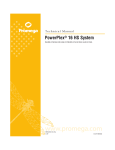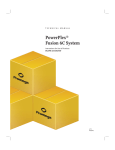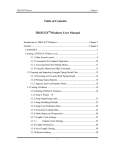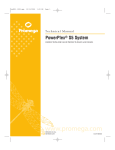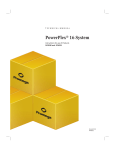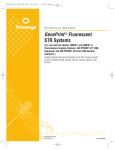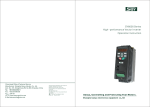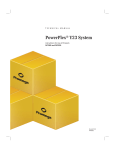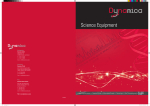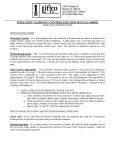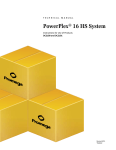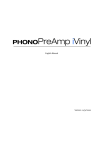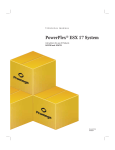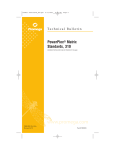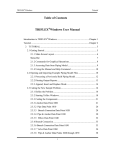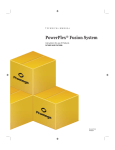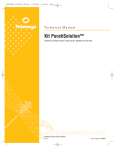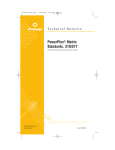Download PowerPlex® CS7 System
Transcript
TECHNICAL MANUAL PowerPlex® CS7 System Instructions for use of Product DC6613 NOTE: PowerPlex® CS7 System (Cat.# DC6613) and this Technical Manual #TMD042 are replacements for PowerPlex® CS7 System, Custom (Cat.# X6613), and Technical Manual #TMD030. Revised 6/14 TMD042 tmd042.0614:EIVD_TM.qxd 6/9/2014 1:18 PM Page 1 PowerPlex® CS7 System All technical literature is available on the Internet at: www.promega.com/protocols/ Please visit the web site to verify that you are using the most current version of this Technical Manual. Please contact Promega Technical Services if you have questions on use of this system. E-mail: [email protected] 1. Description..................................................................................................................................2 2. Product Components and Storage Conditions ....................................................................3 3. Before You Begin .......................................................................................................................4 A. Precautions ........................................................................................................................4 B. Spectral Calibration .........................................................................................................5 4. Protocols for DNA Amplification Using the PowerPlex® CS7 System ..........................5 A. Amplification of Extracted DNA...................................................................................6 B. Direct Amplification of DNA from Storage Card Punches.....................................10 C. Direct Amplification of DNA from Swabs.................................................................14 5. Detection of Amplified Fragments Using the ABI PRISM® 3100 or 3100-Avant Genetic Analyzer with Data Collection Software, Version 2.0, or the Applied Biosystems® 3130 or 3130xl Genetic Analyzer with Data Collection Software, Version 3.0 .....................................................17 6. Data Analysis ...........................................................................................................................19 A. Importing PowerPlex® CS7 Panels and Bins Text Files with GeneMapper® ID, Version 3.2 ......................................................................................19 B. Creating a Size Standard with GeneMapper® ID Software, Version 3.2...............20 C. Creating a Databasing or Paternity Analysis Method Using a Global Filter with GeneMapper® ID Software, Version 3.2 .................................22 D. Creating an Analysis Method Without a General Filter in GeneMapper® ID Software, Version 3.2 .....................................................................24 E. Controls ...........................................................................................................................27 F. Results..............................................................................................................................27 7. Troubleshooting.......................................................................................................................29 A. Amplification and Fragment Detection......................................................................29 B. Direct Amplification of DNA from Storage Card Punches.....................................32 C. Direct Amplification of DNA from Swabs.................................................................34 D. GeneMapper® ID Software ...........................................................................................36 8. References .................................................................................................................................39 9. Appendix ...................................................................................................................................40 A. Advantages of STR Typing...........................................................................................40 B. DNA Extraction and Quantitation Methods and Automation Support................42 C. The Internal Lane Standard 600...................................................................................43 D. Composition of Buffers and Solutions........................................................................43 E. Related Products ............................................................................................................44 F. Summary of Changes ....................................................................................................45 Promega Corporation · 2800 Woods Hollow Road · Madison, WI 53711-5399 USA · Toll Free in USA 800-356-9526 · Phone 608-274-4330 · Fax 608-277-2516 · www.promega.com Printed in USA. Revised 6/14 Part# TMD042 Page 1 tmd042.0614:EIVD_TM.qxd 6/9/2014 1. 1:18 PM Page 2 Description STR (short tandem repeat) loci consist of short, repetitive sequence elements 3–7 base pairs in length (1–4). These repeats are well distributed throughout the human genome and are a rich source of highly polymorphic markers, which may be detected using the polymerase chain reaction (5–8). Alleles of STR loci are differentiated by the number of copies of the repeat sequence contained within the amplified region and are distinguished from one another using fluorescence detection following electrophoretic separation. The PowerPlex® CS7 System(a–d) is used for human identification applications and research use. The system allows co-amplification and three-color detection of seven STR loci, including LPL, F13B, FESFPS, F13A01, Penta D, Penta C and Penta E. One primer for each of the LPL, F13B, PESFPS, F13A01 and Penta D loci is labeled with fluorescein (FL); one primer for the Penta E locus is labeled with carboxytetramethylrhodamine (TMR); and one primer for the Penta C locus is labeled with 6-carboxy-4´,5´-dichloro-2´,7´-dimethoxy-fluorescein (JOE). All seven loci are amplified simultaneously in a single tube and analyzed in a single injection. The PowerPlex® CS7 System contains two loci that overlap with loci included in the PowerPlex® 16 HS System: Penta D and Penta E. This feature allows the PowerPlex® CS7 System to be used as a confirmatory kit in paternity applications using the five unshared STR loci to supplement the genotype and increase the available information. The PowerPlex® CS7 System is compatible with the ABI PRISM® 3100 and 3100Avant Genetic Analyzers and Applied Biosystems® 3130 and 3130xl Genetic Analyzers. The protocols presented in this manual were tested at Promega Corporation. Amplification and detection instrumentation may vary. You may need to optimize protocols including amount of template DNA, cycle number, injection conditions and loading volume for your laboratory instrumentation. In-house validation should be performed. The PowerPlex® CS7 System provides all materials necessary to amplify STR regions of purified human genomic DNA. This manual contains separate protocols for use of the PowerPlex® CS7 System with GeneAmp® PCR System 9600 and 9700 thermal cyclers in addition to protocols to separate amplified products and detect separated material (Figure 1). Protocols to operate the fluorescence-detection instruments should be obtained from the instrument manufacturer. Information about other Promega fluorescent STR systems is available upon request from Promega or online at: www.promega.com Promega Corporation · 2800 Woods Hollow Road · Madison, WI 53711-5399 USA · Toll Free in USA 800-356-9526 · Phone 608-274-4330 · Fax 608-277-2516 · www.promega.com Part# TMD042 Page 2 Printed in USA. Revised 6/14 tmd042.0614:EIVD_TM.qxd 6/9/2014 1:18 PM Page 3 Amplification Setup Section 4 Thermal Cycling Section 4 GeneAmp® PCR System 9700 GeneAmp® PCR System 9600 Instrument Setup and Sample Preparation Section 5 Applied Biosystems® 3130 or 3130xl Genetic Analyzer with Data Collection Software, Version 3.0 ABI PRISM® 3100 or 3100-Avant Genetic Analyzer with Data Collection Software, Version 2.0 Data Analysis Section 6 GeneMapper® ID Software, Version 3.2 Figure 1. An overview of the PowerPlex® CS7 System protocol. 2. Product Components and Storage Conditions Product PowerPlex® CS7 System Size 100 reactions Cat.# DC6613 Not For Medical Diagnostic Use. This system contains sufficient reagents for 100 reactions of 25µl each. Includes: Pre-amplification Components Box 500µl PowerPlex® HS 5X Master Mix 250µl PowerPlex® CS7 10X Primer Pair Mix 25µl 2800M Control DNA, 10ng/µl 2 × 1.25ml Water, Amplification Grade Post-amplification Components Box 50µl PowerPlex® CS7 Allelic Ladder Mix 150µl Internal Lane Standard 600 ! The PowerPlex® CS7 Allelic Ladder Mix, is provided in a separate, sealed bag for shipping. This component should be moved to the post-amplification box after opening. ! PowerPlex® HS 5X Master Mix and PowerPlex® CS7 10X Primer Pair Mix are manufactured as a matched set for optimal performance. Do not combine components from kits with different lot numbers (printed on the boxes and Certificates of Analysis). If lots are mixed, locus-to-locus imbalance and variation in signal intensity may occur. Promega Corporation · 2800 Woods Hollow Road · Madison, WI 53711-5399 USA · Toll Free in USA 800-356-9526 · Phone 608-274-4330 · Fax 608-277-2516 · www.promega.com Printed in USA. Revised 6/14 Part# TMD042 Page 3 tmd042.0614:EIVD_TM.qxd 6/9/2014 2. 1:18 PM Page 4 Product Components and Storage Conditions (continued) Storage Conditions: Store all components except the 2800M Control DNA at –30°C to –10°C in a nonfrost-free freezer. Store the 2800M Control DNA at 2–10°C. The PowerPlex® CS7 10X Primer Pair Mix, PowerPlex® CS7 Allelic Ladder Mix and Internal Lane Standard 600 (ILS 600) are light-sensitive and must be stored in the dark. We strongly recommend that pre-amplification and post-amplification reagents be stored and used separately with different pipettes, tube racks, etc. Available Separately The proper panels and bins text files for use with GeneMapper® ID software can be obtained from the Promega web site at: www.promega.com/resources/tools/genemapper-id-software-panels-and-bin-sets/ Product PowerPlex® Matrix Standards, 3100/3130 Size 25µl (each dye) Cat.# DG4650 Not For Medical Diagnostic Use. Matrix standards are required for initial setup of the color separation matrix. The matrix standards are sold separately and are available for the ABI PRISM® 3100 and 3100-Avant Genetic Analyzers and Applied Biosystems® 3130 and 3130xl Genetic Analyzers (PowerPlex® Matrix Standards, 3100/3130). See Section 9.E for ordering information. 3. Before You Begin 3.A. Precautions The application of PCR-based typing for forensic or paternity casework requires validation studies and quality-control measures that are not contained in this manual (9,10). Guidelines for the validation process are published in the Internal Validation of STR Systems Reference Manual (11). The quality of purified DNA, small changes in buffers, ionic strength, primer concentrations, choice of thermal cycler and thermal cycling conditions can affect PCR success. We suggest strict adherence to recommended procedures for amplification and fluorescence detection. Additional research and validation are required if any modifications are made to the recommended protocols. PCR-based STR analysis is subject to contamination by very small amounts of human DNA. Extreme care should be taken to avoid cross-contamination when preparing sample DNA, handling primer pairs, assembling amplification reactions and analyzing amplification products. Reagents and materials used prior to amplification (PowerPlex® HS 5X Master Mix, 2800M Control DNA and PowerPlex® CS7 10X Primer Pair Mix) are provided in a separate box and should be stored separately from those used following amplification (PowerPlex® CS7 Allelic Ladder Mix and Internal Lane Standard 600). Promega Corporation · 2800 Woods Hollow Road · Madison, WI 53711-5399 USA · Toll Free in USA 800-356-9526 · Phone 608-274-4330 · Fax 608-277-2516 · www.promega.com Part# TMD042 Page 4 Printed in USA. Revised 6/14 tmd042.0614:EIVD_TM.qxd 6/9/2014 1:18 PM Page 5 Always include a negative control reaction (i.e., no template) to detect reagent contamination. We highly recommend the use of gloves and aerosol-resistant pipette tips (e.g., ART® tips, Section 9.E). Some reagents used in the analysis of STR products are potentially hazardous and should be handled accordingly. Formamide is an irritant and a teratogen; avoid inhalation and contact with skin. Read the warning label, and take appropriate precautions when handling this substance. Always wear gloves and safety glasses when working with formamide. 3.B. Spectral Calibration Proper spectral calibration is critical to evaluate multicolor systems with the ABI PRISM® 3100 and 3100-Avant Genetic Analyzers and Applied Biosystems® 3130 and 3130xl Genetic Analyzers. A matrix must be generated for each individual instrument. The PowerPlex® Matrix Standards, 3100/3130 (Cat.# DG4650), is required for spectral calibration on the ABI PRISM® 3100 and 3100-Avant Genetic Analyzers and Applied Biosystems® 3130 and 3130xl Genetic Analyzers. For protocols and additional information on spectral calibration, see the PowerPlex ® Matrix Standards, 3100/3130, Technical Bulletin #TBD022, available online at: www.promega.com/protocols/ Protocols for DNA Amplification Using the PowerPlex® CS7 System 4. The PowerPlex® CS7 System is optimized for the GeneAmp® PCR System 9700 thermal cycler. An amplification protocol for the GeneAmp® PCR System 9600 thermal cycler also is provided. The use of gloves and aerosol-resistant pipette tips is highly recommended to prevent cross-contamination. Keep all pre-amplification and post-amplification reagents in separate rooms. Prepare amplification reactions in a room dedicated for reaction setup. Use equipment and supplies dedicated for amplification setup. Meticulous care must be taken to ensure successful amplification. A guide to amplification troubleshooting is provided in Section 7. ! The concentration of 2800M Control DNA was determined by measuring absorbance at 260nm. Quantification of this control DNA by other methods, such as qPCR, may result in a different value. Prepare a fresh DNA dilution for each set of amplifications. Do not store dilute DNA (e.g., 0.25ng/μl or less). Promega Corporation · 2800 Woods Hollow Road · Madison, WI 53711-5399 USA · Toll Free in USA 800-356-9526 · Phone 608-274-4330 · Fax 608-277-2516 · www.promega.com Printed in USA. Revised 6/14 Part# TMD042 Page 5 tmd042.0614:EIVD_TM.qxd 6/9/2014 1:18 PM Page 6 4.A. Amplification of Extracted DNA We routinely amplify 0.5ng of template DNA in a 25µl reaction volume using the protocols detailed below. Expect to see high peak heights at the smaller loci and relatively lower peak heights at the larger loci if more than the recommended amount of template is used. Reduce the amount of template DNA or number of cycles to correct this. Materials to Be Supplied by the User • GeneAmp® PCR System 9600 and 9700 thermal cycler (Applied Biosystems) • microcentrifuge • MicroAmp® optical 96-well reaction plate or 0.2ml MicroAmp® reaction tubes (Applied Biosystems) • aerosol-resistant pipette tips (see Section 9.E) Amplification Setup 1. Thaw the PowerPlex® HS 5X Master Mix, PowerPlex® CS7 10X Primer Pair Mix and Water, Amplification Grade, completely. Notes: 1. PowerPlex® HS 5X Master Mix and PowerPlex® CS7 10X Primer Pair Mix are manufactured as a matched set for optimal performance. Do not combine components from kits with different lot numbers (printed on the boxes and Certificates of Analyses). If lots are mixed, locus-to-locus imbalance and variation in signal intensity may occur. 2. Centrifuge tubes briefly to bring contents to the bottom, then vortex reagents for 15 seconds before each use. Do not centrifuge the 10X Primer Pair Mix or 5X Master Mix after vortexing, as this may cause the reagents to be concentrated at the bottom of the tube. 2. Determine the number of reactions to be set up. This should include positive and negative control reactions. Add 1 or 2 reactions to this number to compensate for pipetting error. While this approach does consume a small amount of each reagent, it ensures that you will have enough PCR amplification mix for all samples. It also ensures that each reaction contains the same PCR amplification mix. 3. Use a clean MicroAmp® plate for reaction assembly, and label appropriately. Alternatively, determine the number of clean, 0.2ml reaction tubes required, and label appropriately. Promega Corporation · 2800 Woods Hollow Road · Madison, WI 53711-5399 USA · Toll Free in USA 800-356-9526 · Phone 608-274-4330 · Fax 608-277-2516 · www.promega.com Part# TMD042 Page 6 Printed in USA. Revised 6/14 tmd042.0614:EIVD_TM.qxd 4. ! 6/9/2014 1:18 PM Page 7 Add the final volume of each reagent listed in Table 1 to a sterile tube. Amplification of >1.0ng of DNA template results in an imbalance in peak heights from locus to locus. The smaller loci show greater amplification yield than the larger loci. Reducing the number of cycles in the amplification program by 2 to 4 cycles (i.e., 10/20 or 10/18 cycling) can improve locus-to-locus balance. Table 1. PCR Amplification Mix for Amplification of Extracted DNA. PCR Amplification Mix Component1 Water, Amplification Grade Volume Per Reaction × to a final volume of 25.0µl × Number of Reactions = = PowerPlex® HS 5X Master Mix 5.0µl × = PowerPlex® 2.5µl × = CS7 10X Primer Pair Mix template DNA (0.5ng) 2,3 total reaction volume Final Volume up to 17.5µl 25µl 1Add Water, Amplification Grade, to the tube first, then add PowerPlex® HS 5X Master Mix and PowerPlex® CS7 10X Primer Pair Mix. The template DNA will be added at Step 6. 2Store DNA templates in TE–4 buffer (10mM Tris-HCl [pH 8.0], 0.1mM EDTA) or TE–4 buffer with 20µg/ml glycogen. If the DNA template is stored in TE buffer that is not pH 8.0 or contains a higher EDTA concentration, the volume of DNA added should not exceed 20% of the final reaction volume. PCR amplification efficiency and quality can be greatly altered by changes in pH (due to added Tris-HCl), available magnesium concentration (due to chelation by EDTA) or other PCR inhibitors, which may be present at low concentrations depending on the source of the template DNA and the extraction procedure used. 3Apparent DNA concentrations can differ, depending on the DNA quantification method used (12). The amount of DNA template recommended here is based on DNA concentrations determined by measuring absorbance at 260nm. We strongly recommend that you perform experiments to determine the optimal DNA amount based on your particular DNA quantification method. 5. ! 6. Vortex the PCR amplification mix for 5–10 seconds, then pipet PCR amplification mix into each reaction well. Failure to vortex the PCR amplification mix sufficiently can result in poor amplification, peak height imbalance and extra peaks in the range of 50–80bp. Add the template DNA (0.5ng) for each sample to the respective well containing PCR amplification mix. Promega Corporation · 2800 Woods Hollow Road · Madison, WI 53711-5399 USA · Toll Free in USA 800-356-9526 · Phone 608-274-4330 · Fax 608-277-2516 · www.promega.com Printed in USA. Revised 6/14 Part# TMD042 Page 7 tmd042.0614:EIVD_TM.qxd 6/9/2014 1:18 PM Page 8 4.A. Amplification of Extracted DNA (continued) 7. For the positive amplification control, vortex the tube of 2800M Control DNA, then dilute an aliquot to 0.5ng in the desired template DNA volume. Add 0.5ng of the diluted DNA to a reaction well containing PCR amplification mix. 8. For the negative amplification control, pipet Water, Amplification Grade, or TE–4 buffer instead of template DNA into a reaction tube containing PCR amplification mix. 9. Seal the plate, or close the tubes. Optional: Briefly centrifuge the plate to bring contents to the bottom of the wells and remove any air bubbles. Thermal Cycling This manual contains protocols for use of the PowerPlex® CS7 System with the GeneAmp® PCR System 9600 and 9700 thermal cyclers. For information on other thermal cyclers, contact Promega Technical Services by e-mail at: [email protected] Amplification and detection instrumentation may vary. You may need to optimize protocols including the amount of template DNA, cycle number, injection conditions and loading volume for your laboratory instrumentation. Testing at Promega Corporation shows that 10/20 cycles work well for 0.5ng of purified DNA templates. The cycle number can be increased to 10/22 to maximize sensitivity. For higher template amounts or to decrease sensitivity, fewer cycles, such as 10/18 should be evaluated. In-house validation should be performed. 1. Place MicroAmp® plate or reaction tubes in the thermal cycler. Promega Corporation · 2800 Woods Hollow Road · Madison, WI 53711-5399 USA · Toll Free in USA 800-356-9526 · Phone 608-274-4330 · Fax 608-277-2516 · www.promega.com Part# TMD042 Page 8 Printed in USA. Revised 6/14 tmd042.0614:EIVD_TM.qxd 6/9/2014 1:18 PM Page 9 2. Select and run the recommended protocol. The preferred protocols for use with the GeneAmp® PCR System 9600 and 9700 thermal cyclers are provided below. 3. After completion of the thermal cycling protocol, store amplified samples at –20°C in a light-protected box. Note: Long-term storage of amplified samples at 4°C or higher may produce artifacts. Protocol for the GeneAmp® PCR System 9700 Thermal Cycler1,2 Protocol for the GeneAmp® PCR System 9600 Thermal Cycler 96°C for 2 minutes, then: 96°C for 2 minutes, then: ramp 100% to 94°C for 30 seconds ramp 29% to 60°C for 30 seconds ramp 23% to 70°C for 45 seconds for 10 cycles, then: 94°C for 30 seconds ramp 68 seconds to 60°C (hold for 30 seconds) ramp 50 seconds to 70°C (hold for 45 seconds) for 10 cycles, then: ramp 100% to 90°C for 30 seconds ramp 29% to 60°C for 30 seconds ramp 23% to 70°C for 45 seconds for 20 cycles, then: 90°C for 30 seconds ramp 60 seconds to 60°C (hold for 30 seconds) ramp 50 seconds to 70°C (hold for 45 seconds) for 20 cycles, then: 60°C for 30 minutes 4°C soak 60°C for 30 minutes 4°C soak 1When using the GeneAmp® PCR System 9700 thermal cycler, the ramp rates indicated in the cycling program must be set. For the GeneAmp® PCR System 9700 thermal cycler with a 96-well block, the program must be run in the 9600 ramp mode. The 9600 ramp mode on the GeneAmp® PCR System 9700 thermal cycler with the 384-well dual block ramps does not exist and is not required to program ramp rates. The ramp rates are set in the Ramp Rate Modification screen. While viewing the cycling program, navigate to the Ramp Rate Modification screen by selecting "More", then "Modify". On the Ramp Rate Modification screen the default rates for each step are 100%. The rate under each hold step is the rate at which the temperature will change to that hold temperature. Figure 2 shows the appropriate ramp rates for the GeneAmp® PCR System 9700 thermal cycler. The ramp mode is set after “start” is selected for the thermal cycling run. A Select Method Options screen appears. Select 9600 ramp mode, and enter the reaction volume. 2Using 10/20 cycles works well for routine testing. For maximum sensitivity cycle number can be increased to 10/22. 94.0°C 100% 70.0°C 23% 60.0°C 29% 3 tmp 22 cycles 90.0°C 100% 70.0°C 23% 60.0°C 29% 7486MA 3 tmp 10 cycles Figure 2. The ramp rates for the GeneAmp® PCR System 9700 thermal cycler. Promega Corporation · 2800 Woods Hollow Road · Madison, WI 53711-5399 USA · Toll Free in USA 800-356-9526 · Phone 608-274-4330 · Fax 608-277-2516 · www.promega.com Printed in USA. Revised 6/14 Part# TMD042 Page 9 tmd042.0614:EIVD_TM.qxd 6/9/2014 1:18 PM Page 10 4.B. Direct Amplification of DNA from Storage Card Punches Materials to Be Supplied by the User • GeneAmp® PCR System 9700 thermal cycler (Applied Biosystems) • microcentrifuge • MicroAmp® optical 96-well reaction plate (Applied Biosystems) • aerosol-resistant pipette tips (see Section 9.E) • PunchSolution™ Kit (Cat.# DC9271) for nonFTA card punches; this kit includes the 5X AmpSolution™ Reagent • 1.2mm Harris Micro-Punch or equivalent manual punch and cutting mat or automated punch system This section contains a protocol for direct amplification of DNA from storage card punches using the PowerPlex® CS7 System and GeneAmp® PCR System 9700 thermal cycler. When using the protocol detailed below, add the number of 1.2mm storage card punches indicated below to each 25μl amplification reaction. Note: You will need to optimize and validate the number of storage card punches per reaction in your laboratory. FTA®-based sample types include: • Buccal cells collected on FTA® cards with Whatman EasiCollect™ or Fitzco Sampact™ devices (one or two punches per 25µl amplification reaction) • Buccal cells collected with sterile swabs transferred to FTA® or Indicating FTA® cards (one or two punches per 25µl amplification reaction) • Liquid blood (from collection or storage Vacutainer ® tubes or finger sticks) spotted onto FTA® cards (one punch per 25µl amplification reaction) NonFTA sample types include: • Buccal samples on Bode Buccal DNA Collector™ devices (one punch per 25µl amplification reaction) • Blood and buccal samples on nonFTA card punches (e.g., S&S 903) (one punch per 25µl amplification reaction) Pretreat these sample types with the PunchSolution™ Reagent (Cat.# DC9271) to lyse nonFTA samples before adding the amplification mix. For more information, see the PunchSolution™ Kit Technical Manual #TMD038. Failure to pretreat these samples may result in incomplete profiles. Use a manual punch tool with a 1.2mm tip to manually create sample disks from a storage card. Place tip near the center of the sample spot, and with a twisting or pressing action, cut a 1.2mm sample disk. Use the plunger to eject the disk into the appropriate well of a reaction plate. Automated punchers also can be used to create sample disks. Refer to the user’s guide for your instrument for assistance with generating 1.2mm disks, technical advice and troubleshooting information. Promega Corporation · 2800 Woods Hollow Road · Madison, WI 53711-5399 USA · Toll Free in USA 800-356-9526 · Phone 608-274-4330 · Fax 608-277-2516 · www.promega.com Part# TMD042 Page 10 Printed in USA. Revised 6/14 tmd042.0614:EIVD_TM.qxd 6/9/2014 1:18 PM Page 11 Note: Static may be problematic when adding a punch to a well. For FTA® card punches adding PCR amplification mix to the well before adding the punch may help alleviate static problems. Amplification Setup 1. Thaw the PowerPlex® HS 5X Master Mix, PowerPlex® CS7 10X Primer Pair Mix and Water, Amplification Grade, completely. Note: Centrifuge tubes briefly to bring contents to the bottom, then vortex reagents for 15 seconds before each use. Do not centrifuge the 10X Primer Pair Mix or 5X Master Mix after vortexing, as this may cause the reagents to be concentrated at the bottom of the tube. 2. Determine the number of reactions to be set up. This should include positive and negative control reactions. Add 1 or 2 reactions to this number to compensate for pipetting error. While this approach does consume a small amount of each reagent, it ensures that you will have enough PCR amplification mix for all samples. It also ensures that each reaction contains the same PCR amplification mix. 3. Use a clean MicroAmp® plate for reaction assembly, and label appropriately. 4. Add the final volume of each reagent listed in Table 2 to a sterile tube. Table 2. PCR Amplification Mix for Direct Amplification of DNA from Storage Card Punches. PCR Amplification Mix Component1 Volume Per Reaction × Number of Reactions Water, Amplification Grade 12.5µl × = PowerPlex® HS 5X Master Mix PowerPlex® CS7 10X Primer Pair Mix 5.0µl × = 2.5µl × = 5X AmpSolution™ Reagent 5.0µl × = total reaction volume 25µl = Final Volume 1Add Water, Amplification Grade, to the tube first, then add PowerPlex® HS 5X Master Mix and PowerPlex® CS7 10X Primer Pair Mix. For FTA® card punches, the template DNA will be added at Step 6. 5. ! 6. Vortex the PCR amplification mix for 5–10 seconds, then pipet 25µl of PCR amplification mix into each reaction well. Failure to vortex the PCR amplification mix sufficiently can result in poor amplification or locus-to-locus imbalance. For FTA® storage cards, add one or two 1.2mm punches from a card containing a buccal sample or one 1.2mm punch from a card containing whole blood to the appropriate wells of the reaction plate. For nonFTA card punches, add PCR amplification mix to the pretreated punches. Note: It also is acceptable to add the FTA® card punch first, then add the PCR amplification mix. Promega Corporation · 2800 Woods Hollow Road · Madison, WI 53711-5399 USA · Toll Free in USA 800-356-9526 · Phone 608-274-4330 · Fax 608-277-2516 · www.promega.com Printed in USA. Revised 6/14 Part# TMD042 Page 11 tmd042.0614:EIVD_TM.qxd 6/9/2014 1:18 PM Page 12 4.B. Direct Amplification of DNA from Storage Card Punches (continued) 7. For the positive amplification control, vortex the tube of 2800M Control DNA, then add 1μl (10ng) of the 2800M Control DNA to a reaction well containing 25μl of PCR amplification mix. Notes: 8. 1. Do not include blank storage card punches in the positive control reactions. 2. Optimization of the amount of 2800M Control DNA may be required based on thermal cycling conditions and laboratory preferences. Typically, 10ng of 2800M Control DNA is sufficient to provide a robust profile using the cycle numbers recommended here. A onecycle reduction in cycle number will require a twofold increase in mass of DNA template to generate similar signal intensity. Similarly, a one-cycle increase in cycle number will require a twofold reduction in the amount of 2800M Control DNA to avoid signal saturation. Reserve a well containing PCR amplification mix as a negative amplification control. Note: An additional negative control with a blank punch may be performed to detect contamination from the storage card or punch device. 9. Seal the plate, and briefly centrifuge the plate to bring storage card punches to the bottom of the wells and remove any air bubbles. Note: Place the plate in the thermal cycler, and start the thermal cycling program as soon as the PCR amplification mix is added to all wells. Prolonged storage of assembled reactions prior to cycling may result in poor performance (i.e., lower peak heights for large amplicons). Thermal Cycling Amplification and detection instrumentation may vary. You will need to optimize protocols including the number of storage card punches, cycle number, injection conditions and loading volume for each laboratory instrument. Testing at Promega Corporation shows that 10/17 cycling works well for a variety of sample types. Buccal samples may require more amplification cycles than blood samples. Cycle number will need to be optimized in each laboratory for each sample type that is amplified. 1. Place the MicroAmp® plate in the thermal cycler. Promega Corporation · 2800 Woods Hollow Road · Madison, WI 53711-5399 USA · Toll Free in USA 800-356-9526 · Phone 608-274-4330 · Fax 608-277-2516 · www.promega.com Part# TMD042 Page 12 Printed in USA. Revised 6/14 tmd042.0614:EIVD_TM.qxd 2. 6/9/2014 1:18 PM Page 13 Select and run the recommended protocol. The preferred protocol for use with the GeneAmp® PCR System 9700 thermal cycler is provided below. Thermal Cycling Protocol1 96°C for 2 minutes, then: ramp 100% to 94°C for 30 seconds ramp 29% to 60°C for 30 seconds ramp 23% to 70°C for 45 seconds for 10 cycles, then: ramp 100% to 90°C for 30 seconds ramp 29% to 60°C for 30 seconds ramp 23% to 70°C for 45 seconds for 17 cycles, then: 60°C for 30 minutes 4°C soak 1When using the GeneAmp® PCR System 9700 thermal cycler, the ramp rates indicated in the cycling program must be set. For the GeneAmp® PCR System 9700 thermal cycler with a 96-well block, the program must be run in the 9600 ramp mode. The 9600 ramp mode on the GeneAmp® PCR System 9700 thermal cycler with the 384-well dual block ramps does not exist and is not required to program ramp rates. The ramp rates are set in the Ramp Rate Modification screen. While viewing the cycling program, navigate to the Ramp Rate Modification screen by selecting "More", then "Modify". On the Ramp Rate Modification screen the default rates for each step are 100%. The rate under each hold step is the rate at which the temperature will change to that hold temperature. Figure 2 shows the appropriate ramp rates for the GeneAmp® PCR System 9700 thermal cycler. The ramp mode is set after “start” is selected for the thermal cycling run. A Select Method Options screen appears. Select 9600 ramp mode, and enter the reaction volume. 3. After completion of the thermal cycling protocol, store amplified samples at –20°C in a light-protected box. Note: Long-term storage of amplified samples at 4°C or higher may produce artifacts. PCR Optimization Cycle number should be optimized based on the results of an initial experiment to determine the sensitivity with your collection method, sample types and instrumentation. 1. Choose several samples that represent typical sample types you encounter in the laboratory. Prepare them as you would using your normal workflow. 2. Depending on your preferred protocol, place one or two 1.2mm storage card punches containing a buccal sample or one 1.2mm punch of a storage card containing whole blood into each well of a reaction plate. Be sure to pretreat nonFTA samples with the PunchSolution™ Kit (Cat.# DC9271). Promega Corporation · 2800 Woods Hollow Road · Madison, WI 53711-5399 USA · Toll Free in USA 800-356-9526 · Phone 608-274-4330 · Fax 608-277-2516 · www.promega.com Printed in USA. Revised 6/14 Part# TMD042 Page 13 tmd042.0614:EIVD_TM.qxd 6/9/2014 1:18 PM Page 14 4.B. Direct Amplification of DNA from Storage Card Punches (continued) 3. Prepare three identical reaction plates with punches from the same samples. 4. Amplify samples using the thermal cycling protocol provided above, but subject each plate to a different cycle number (10/16, 10/17 and 10/18 cycling). 5. Following amplification, use your laboratory’s validated separation and detection protocols to determine the optimal cycle number for the sample type and number of storage card punches. 4.C. Direct Amplification of DNA from Swabs Materials to Be Supplied by the User • GeneAmp® PCR System 9700 thermal cycler (Applied Biosystems) • microcentrifuge • MicroAmp® optical 96-well reaction plate (Applied Biosystems) • aerosol-resistant pipette tips (see Section 9.E) • SwabSolution™ Kit (Cat.# DC8271) This section contains a protocol for amplifying swab extracts using the PowerPlex® CS7 System and GeneAmp® PCR System 9700 thermal cycler. Pretreat cotton or OmniSwabs™ (GE Healthcare) swabs with the SwabSolution™ Kit (Cat.# DC8271) as described in the SwabSolution™ Kit Technical Manual #TMD037 to generate a swab extract. Amplification Setup 1. Thaw the PowerPlex® HS 5X Master Mix, PowerPlex® CS7 10X Primer Pair Mix and Water, Amplification Grade, completely. Note: Centrifuge tubes briefly to bring contents to the bottom, then vortex reagents for 15 seconds before each use. Do not centrifuge the 10X Primer Pair Mix or 5X Master Mix after vortexing, as this may cause the reagents to be concentrated at the bottom of the tube. 2. Determine the number of reactions to be set up. This should include positive and negative control reactions. Add 1 or 2 reactions to this number to compensate for pipetting error. While this approach does consume a small amount of each reagent, it ensures that you will have enough PCR amplification mix for all samples. It also ensures that each reaction contains the same PCR amplification mix. 3. Use a clean MicroAmp® plate for reaction assembly, and label appropriately. Promega Corporation · 2800 Woods Hollow Road · Madison, WI 53711-5399 USA · Toll Free in USA 800-356-9526 · Phone 608-274-4330 · Fax 608-277-2516 · www.promega.com Part# TMD042 Page 14 Printed in USA. Revised 6/14 tmd042.0614:EIVD_TM.qxd 4. 6/9/2014 1:18 PM Page 15 Add the final volume of each reagent listed in Table 3 to a sterile tube. Table 3. PCR Amplification Mix for Direct Amplification of DNA From Swabs. PCR Amplification Mix Component1 Volume Per Reaction × Number of Reactions = Water, Amplification Grade 10.5µl × = PowerPlex® HS 5X Master Mix PowerPlex® CS7 10X Primer Pair Mix 5.0µl × = 2.5µl × = 5X AmpSolution™ Reagent 5.0µl × = swab extract 2.0µl total reaction volume 25µl Final Volume 1Add Water, Amplification Grade, to the tube first, then add PowerPlex® HS 5X Master Mix and PowerPlex® CS7 10X Primer Pair Mix. The swab extract will be added at Step 6. 5. ! Vortex the PCR amplification mix for 5–10 seconds, then pipet 23µl of PCR amplification mix into each reaction well. Failure to vortex the PCR amplification mix sufficiently can result in poor amplification or locus-to-locus imbalance. 6. Pipet 2.0µl of swab extract for each sample into the appropriate well of the reaction plate. 7. For the positive amplification control, vortex the tube of 2800M DNA, then dilute an aliquot to 2.5ng/μl and add 2μl to a reaction well containing 23μl of PCR amplification mix. Note: Optimization of the amount of 2800M Control DNA may be required, depending on thermal cycling conditions and laboratory preferences. 8. For the negative amplification control, pipet Water, Amplification Grade, or TE–4 buffer instead of swab extract into a reaction well containing PCR amplification mix. Note: Additional negative controls can be included. Assemble a reaction containing the swab extract prepared from a blank swab, or assemble a reaction where the SwabSolution™ Reagent is processed as a blank without a swab. 9. Seal the plate. Optional: Briefly centrifuge the plate to bring contents to the bottom of the wells and remove any air bubbles. Promega Corporation · 2800 Woods Hollow Road · Madison, WI 53711-5399 USA · Toll Free in USA 800-356-9526 · Phone 608-274-4330 · Fax 608-277-2516 · www.promega.com Printed in USA. Revised 6/14 Part# TMD042 Page 15 tmd042.0614:EIVD_TM.qxd 6/9/2014 1:18 PM Page 16 4.C. Direct Amplification of DNA from Swabs (continued) Thermal Cycling Amplification and detection instrumentation may vary. You will need to optimize protocols including amount of template DNA, cycle number, injection conditions and loading volume for your laboratory instrumentation. Testing at Promega Corporation shows that 10/18 cycling works well for a variety of sample types. Cycle number will need to be optimized in each laboratory for each sample type that is amplified (see below). 1. Place the MicroAmp® plate in the thermal cycler. 2. Select and run the recommended protocol. The preferred protocol for use with the GeneAmp® PCR System 9700 thermal cycler is provided below. Thermal Cycling Protocol1 96°C for 2 minutes, then: ramp 100% to 94°C for 30 seconds ramp 29% to 60°C for 30 seconds ramp 23% to 70°C for 45 seconds for 10 cycles, then: ramp 100% to 90°C for 30 seconds ramp 29% to 60°C for 30 seconds ramp 23% to 70°C for 45 seconds for 18 cycles, then: 60°C for 30 minutes 4°C soak 1When using the GeneAmp® PCR System 9700 thermal cycler, the ramp rates indicated in the cycling program must be set. For the GeneAmp® PCR System 9700 thermal cycler with a 96-well block, the program must be run in the 9600 ramp mode. The 9600 ramp mode on the GeneAmp® PCR System 9700 thermal cycler with the 384-well dual block ramps does not exist and is not required to program ramp rates. The ramp rates are set in the Ramp Rate Modification screen. While viewing the cycling program, navigate to the Ramp Rate Modification screen by selecting "More", then "Modify". On the Ramp Rate Modification screen the default rates for each step are 100%. The rate under each hold step is the rate at which the temperature will change to that hold temperature. Figure 2 shows the appropriate ramp rates for the GeneAmp® PCR System 9700 thermal cycler. The ramp mode is set after “start” is selected for the thermal cycling run. A Select Method Options screen appears. Select 9600 ramp mode, and enter the reaction volume. 3. After completion of the thermal cycling protocol, store amplified samples at –20°C in a light-protected box. Note: Long-term storage of amplified samples at 4°C or higher may produce artifacts. Promega Corporation · 2800 Woods Hollow Road · Madison, WI 53711-5399 USA · Toll Free in USA 800-356-9526 · Phone 608-274-4330 · Fax 608-277-2516 · www.promega.com Part# TMD042 Page 16 Printed in USA. Revised 6/14 tmd042.0614:EIVD_TM.qxd 6/9/2014 1:18 PM Page 17 PCR Optimization Cycle number should be optimized based on the results of an initial experiment to determine the sensitivity with your collection method, sample types and instrumentation. 1. Choose several samples that represent typical sample types you encounter in the laboratory. Prepare them as you would using your normal workflow. 2. Prepare three identical reaction plates with aliquots of the same swab extracts. 3. Amplify samples using the thermal cycling protocol provided above, but subject each plate to a different cycle number (10/17, 10/18 and 10/19 cycling). Note: This recommendation is for 2µl of swab extract. Additional cycle number testing may be required. 4. Following amplification, use your laboratory’s validated separation and detection protocols to determine the optimal cycle number for the sample type. Detection of Amplified Fragments Using the ABI PRISM® 3100 or 3100-Avant Genetic Analyzer with Data Collection Software, Version 2.0, or the Applied Biosystems® 3130 or 3130xl Genetic Analyzer with Data Collection Software, Version 3.0 5. Materials to Be Supplied by the User • 95°C dry heating block, water bath or thermal cycler • crushed ice or ice-water bath • centrifuge compatible with 96-well plates • aerosol-resistant pipette tips • 3100 or 3130 capillary array, 36cm • performance optimized polymer 4 (POP-4™) for the 3100 or 3130 • 10X genetic analyzer buffer with EDTA • MicroAmp® optical 96-well plate and septa • Hi-Di™ formamide (Applied Biosystems Cat.# 4311320) ! The quality of formamide is critical. Use Hi-Di™ formamide. Freeze formamide in aliquots at –20°C. Multiple freeze-thaw cycles or long-term storage at 4°C may cause a breakdown of formamide. Poor-quality formamide may contain ions that compete with DNA during injection, which results in lower peak heights and reduced sensitivity. A longer injection time may not increase the signal. ! Formamide is an irritant and a teratogen; avoid inhalation and contact with skin. Read the warning label, and take appropriate precautions when handling this substance. Always wear gloves and safety glasses when working with formamide. Sample Preparation 1. Thaw the Internal Lane Standard 600. Note: Centrifuge tube briefly to bring contents to the bottom, then vortex for 15 seconds before each use. Do not centrifuge after vortexing, as this may cause the size standard to be concentrated at the bottom of the tube. Promega Corporation · 2800 Woods Hollow Road · Madison, WI 53711-5399 USA · Toll Free in USA 800-356-9526 · Phone 608-274-4330 · Fax 608-277-2516 · www.promega.com Printed in USA. Revised 6/14 Part# TMD042 Page 17 tmd042.0614:EIVD_TM.qxd 6/9/2014 5. 1:18 PM Page 18 Detection of Amplified Fragments Using the ABI PRISM® 3100 or 3100-Avant Genetic Analyzer with Data Collection Software, Version 2.0, or the Applied Biosystems® 3130 or 3130xl Genetic Analyzer with Data Collection Software, Version 3.0 (continued) 2. Prepare a loading cocktail by combining and mixing Internal Lane Standard 600 and Hi-Di™ formamide as follows: [(0.5µl ILS 600) × (# samples)] + [(9.5µl Hi-Di™ formamide) × (# samples)] Note: The volume of internal lane standard used in the loading cocktail can be increased or decreased to adjust the intensity of the size standard peaks. The optimal peak height for the 100-base fragment of the internal lane standard is 500–1,000RFU. If peak heights are too low, we recommend altering the formamide/internal lane standard mix to contain 1.0µl of ILS 600 and 9.0µl of Hi-Di™ formamide. If peak heights are too high, we recommend altering the loading cocktail to contain 0.25µl of ILS 600 and 9.75µl of formamide. 3. Vortex for 10–15 seconds to mix. 4. Pipet 10µl of formamide/internal lane standard mix into each well. 5. Add 1µl of amplified sample (or 1µl of PowerPlex® CS7 Allelic Ladder Mix). Cover wells with appropriate septa. Note: Instrument detection limits vary; therefore, injection time, injection voltage or the amount of product mixed with loading cocktail may need to be adjusted. Use the Module Manager in the data collection software to modify the injection time or voltage in the run module. If peak heights are higher than desired, use less DNA template in the amplification reaction or reduce the number of cycles in the amplification program by 2–4 cycles to achieve the desired signal intensity. 6. Centrifuge plate briefly to remove air bubbles from the wells. 7. Denature samples at 95°C for 3 minutes, then immediately chill on crushed ice or in an ice-water bath for 3 minutes. Denature samples just prior to loading the instrument. Instrument Preparation Refer to the instrument users’ manual for instructions on cleaning, installing the capillary array, performing a spatial calibration and adding polymer. Analyze samples as described in the user’s manual for the ABI PRISM® 3100 or 3100Avant Genetic Analyzer with Data Collection Software, Version 2.0, and the Applied Biosystems® 3130 or 3130xl Genetic Analyzer with the following exceptions. 1. In the Module Manager, select “New”. Select “Regular” in the Type drop-down list, and select “HIDFragmentAnalysis36_POP4” in the Template drop-down list. Confirm that the injection time is 5 seconds and the injection voltage is 3kV. Lengthen the run time to 2,000 seconds. Give a descriptive name to your run module, and select “OK”. Note: Instrument sensitivities can vary. The injection time and voltage may be adjusted in the Module Manager. A suggested range for the injection time is 3–22 seconds and for the injection voltage is 1–3kV. Promega Corporation · 2800 Woods Hollow Road · Madison, WI 53711-5399 USA · Toll Free in USA 800-356-9526 · Phone 608-274-4330 · Fax 608-277-2516 · www.promega.com Part# TMD042 Page 18 Printed in USA. Revised 6/14 tmd042.0614:EIVD_TM.qxd 6/9/2014 1:18 PM Page 19 2. In the Protocol Manager, select “New”. Type a name for your protocol. Select “Regular” in the Type drop-down list, and select the run module you created in the previous step in the Run Module drop-down list. Lastly, select “F” in the Dye-Set drop-down list. Select “OK. 3. In the Plate Manager, create a new plate record as described in the instrument user’s manual. In the dialog box that appears, select “GeneMapper—Generic” in the Application drop-down list, and select the appropriate plate type (96-well). Add entries in the owner and operator windows, and select “OK”. Note: If autoanalysis of sample data is desired, refer to the instrument user’s manual for instructions. 4. In the GeneMapper® plate record, enter sample names in the appropriate cells. Scroll to the right. In the Results Group 1 column, select the desired results group. In the Instrument Protocol 1 column, select the protocol you created in Step 2. Be sure this information is present for each row that contains a sample name. Select “OK”. Note: To create a new results group, select “New” in the drop-down menu in the Results Group column. Select the General tab, and enter a name. Select the Analysis tab, and select “GeneMapper—Generic” in the Analysis type dropdown list. 5. Place samples in the instrument, and close the instrument doors. 6. In the spectral viewer, confirm that dye set F is active, and set the correct active calibration for dye set F. 7. In the run scheduler, locate the plate record that you just created in Steps 3 and 4, and click once on the name to highlight it. 8. Once the plate record is highlighted, click the plate graphic that corresponds to the plate on the autosampler that contains your amplified samples. 9. When the plate record is linked to the plate, the plate graphic will change from yellow to green, and the green Run Instrument arrow becomes enabled. 10. Click on the green Run Instrument arrow on the toolbar to start the sample run. 11. Monitor electrophoresis by observing the run, view, array or capillaries viewer window in the data collection software. Each injection will take approximately 45 minutes. 6. Data Analysis 6.A. Importing PowerPlex® CS7 Panels and Bins Text Files with GeneMapper ® ID, Version 3.2 To facilitate analysis of data generated with the PowerPlex® CS7 System, we have created panels and bins text files to allow automatic assignment of genotypes using GeneMapper® ID software, version 3.2. We recommend that users of GeneMapper ® ID software, version 3.2, complete the Applied Biosystems GeneMapper ® ID Software Human Identification Analysis Tutorial to familiarize themselves with proper operation of the software. For GeneMapper® ID software, version 3.1, users we recommend upgrading to version 3.2. Promega Corporation · 2800 Woods Hollow Road · Madison, WI 53711-5399 USA · Toll Free in USA 800-356-9526 · Phone 608-274-4330 · Fax 608-277-2516 · www.promega.com Printed in USA. Revised 6/14 Part# TMD042 Page 19 tmd042.0614:EIVD_TM.qxd 6/9/2014 1:18 PM Page 20 6.A. Importing PowerPlex® CS7 Panels and Bins Text Files with GeneMapper ® ID, Version 3.2 (continued) Getting Started 1. To obtain the panels and bins text files for the PowerPlex® CS7 System go to: www.promega.com/resources/tools/genemapper-id-software-panelsand-bin-sets/ 2. Enter your contact information, and select “GeneMapper ID” and the control DNA that you use. Select “Submit”. 3. Save the PowerPlex_CS7_Panels_vX.x.txt and PowerPlex_CS7_Bins_vX.x.txt files, where “X.x” refers to the most recent version of the panels and bins text files, to a known location on your computer. Importing Panels and Bins Text Files These instructions loosely follow the Applied Biosystems GeneMapper® ID software tutorial, pages 1–4. 1. Open the GeneMapper® ID software, version 3.2. 2. Select “Tools”, then “Panel Manager”. 3. Highlight the Panel Manager icon in the upper left navigation pane. 4. Select “File”, then “Import Panels”. 5. Navigate to the panels text file that was obtained in the Getting Started Section above. Select the file, then “Import”. 6. In the navigation pane, highlight the Promega 16 HS CS7 panels folder that you just imported in Step 5. 7. Select “File”, then “Import Bin Set”. 8. Navigate to the bins text file that was obtained in the Getting Started Section above. Select the file, then “Import”. 9. At the bottom of the Panel Manager window, select “OK”. The Panel Manager window will close automatically. 6.B. Creating a Size Standard with GeneMapper® ID Software, Version 3.2 1. Select “Tools”, then “GeneMapper Manager”. 2. Select the Size Standard tab. 3. Select “New”. 4. Select “Basic or Advanced” (Figure 3). The type of analysis method selected must match the type of analysis method created earlier. Select “OK”. Promega Corporation · 2800 Woods Hollow Road · Madison, WI 53711-5399 USA · Toll Free in USA 800-356-9526 · Phone 608-274-4330 · Fax 608-277-2516 · www.promega.com Part# TMD042 Page 20 Printed in USA. Revised 6/14 6/9/2014 1:18 PM Page 21 5725TA tmd042.0614:EIVD_TM.qxd Figure 3. The Select Dye and Analysis Method window. Enter a detailed name, such as “ILS 600 advanced”, in the Size Standard Editor (Figure 4). 5726TA 5. Figure 4. The Size Standard Editor. 6. Choose “Red” for the Size Standard Dye. 7. Enter the sizes of the internal lane standard fragments (60, 80, 100, 120, 140, 160, 180, 200, 225, 250, 275, 300, 325, 350, 375, 400, 425, 450, 475, 500, 550 and 600 bases). Note: Definition and detection of the 600bp fragment is optional. 8. Select “OK”. Promega Corporation · 2800 Woods Hollow Road · Madison, WI 53711-5399 USA · Toll Free in USA 800-356-9526 · Phone 608-274-4330 · Fax 608-277-2516 · www.promega.com Printed in USA. Revised 6/14 Part# TMD042 Page 21 tmd042.0614:EIVD_TM.qxd 6/9/2014 1:18 PM Page 22 6.C. Creating a Databasing or Paternity Analysis Method Using a Global Filter with GeneMapper ® ID Software, Version 3.2 1. Select “Tools”, then “GeneMapper Manager”. 2. Select the Analysis Methods tab. 3. Select “New”, and a new analysis method dialog box will open. 4. Select “HID”, and select “OK”. Note: If you do not see the HID option, you do not have the GeneMapper® ID software. Contact Applied Biosystems. Enter a descriptive name for the analysis method, such as “PowerPlexCS7_20%filter”. 6. Select the Allele tab (Figure 5). 7. Select the bins text file that was obtained in Section 6.A. 8. Ensure that the “Use marker-specific stutter ratio if available” box is checked. 9. Enter the values shown in Figure 5 for proper filtering of peaks when using the PowerPlex® CS7 System. For an explanation of the proper usage and effect of these settings, refer to the Applied Biosystems user bulletin titled “Installation Procedures and New Features for GeneMapper ID Software 3.2”. 8836TA 5. Figure 5. The Allele tab with settings for using a 20% peak filter. Promega Corporation · 2800 Woods Hollow Road · Madison, WI 53711-5399 USA · Toll Free in USA 800-356-9526 · Phone 608-274-4330 · Fax 608-277-2516 · www.promega.com Part# TMD042 Page 22 Printed in USA. Revised 6/14 tmd042.0614:EIVD_TM.qxd 6/9/2014 1:18 PM Page 23 10. Select the Peak Detector tab. We recommend the settings shown in Figure 6. Notes: Select full range or partial range for the analysis range. When using a partial range, choose an appropriate analysis range based on your data. Choose a start point after the primer peak and just before the first defined internal lane standard peak to help ensure proper sizing of the internal lane standard. 2. The peak amplitude thresholds are the minimum peak heights at which the software will call a peak. Values for peak amplitude thresholds are usually 50–150RFU and should be determined by individual laboratories. 8835TA 1. Figure 6. The Peak Detector tab. 11. Select the Peak Quality tab. You may change the settings for peak quality. Note: For Steps 11 and 12, see the GeneMapper® ID user’s manual for more information. 12. Select the Quality Flags tab. You may change these settings. 13. Select “OK” to save your settings. Promega Corporation · 2800 Woods Hollow Road · Madison, WI 53711-5399 USA · Toll Free in USA 800-356-9526 · Phone 608-274-4330 · Fax 608-277-2516 · www.promega.com Printed in USA. Revised 6/14 Part# TMD042 Page 23 tmd042.0614:EIVD_TM.qxd 6/9/2014 1:18 PM Page 24 6.C. Creating a Databasing or Paternity Analysis Method Using a Global Filter with GeneMapper ® ID Software, Version 3.2 (continued) Processing Data for Databasing or Paternity Samples 1. Select “File”, then “New Project”. 2. Select “Edit”, then “Add Samples to Project”. 3. Browse to the location of the run files. Highlight desired files, then select “Add to list” followed by “Add”. 4. In the Sample Type column, use the drop-down menu to select “Ladder”, “Sample”, “Positive Control” or “Negative Control” as appropriate for the sample. Every folder in the project must contain at least one allelic ladder injection that is designated as“Ladder” in the Sample Type column for proper genotyping. 5. In the Analysis Method column, select the analysis method created previously in this section. 6. In the Panel column, select the panels text file that was imported in Section 6.A. 7. In the Size Standard column, select the size standard that was created in Section 6.B. 8. Select “Analyze” (green arrow button) to start the data analysis. 6.D. Creating an Analysis Method Without a General Filter in GeneMapper ® ID Software, Version 3.2 These instructions loosely follow the Applied Biosystems GeneMapper® ID software tutorial, pages 1–11. 1. Select “Tools”, then “GeneMapper Manager”. 2. Select the Analysis Methods tab. 3. Select “New”, and a new analysis method dialog box will open. 4. Select “HID”, and select “OK”. Note: If you do not see the HID option, you do not have the GeneMapper® ID software. Contact Applied Biosystems. 5. Enter a descriptive name for the analysis method, such as “PowerPlexCS7 advanced”. 6. Select the Allele tab (Figure 7). 7. Select the bins text file that was imported in Section 6.A. 8. Ensure that the “Use marker-specific stutter ratio if available” box is checked. Promega Corporation · 2800 Woods Hollow Road · Madison, WI 53711-5399 USA · Toll Free in USA 800-356-9526 · Phone 608-274-4330 · Fax 608-277-2516 · www.promega.com Part# TMD042 Page 24 Printed in USA. Revised 6/14 tmd042.0614:EIVD_TM.qxd 9. 6/9/2014 1:18 PM Page 25 Enter the values shown in Figure 7 for proper filtering of stutter peaks when using the PowerPlex® CS7 System. For an explanation of the proper usage and effects of these settings, refer to the Applied Biosystems user bulletin titled “Installation Procedures and New Features for GeneMapper ID Software 3.2”. 8834TA Note: Some of these settings have been optimized and are different from the recommended settings in the user bulletin. Figure 7. The Allele tab. 10. Select the Peak Detector tab. We recommend the settings shown in Figure 8. Notes: 1. Select full range or partial range for the analysis range. When using a partial range, choose an appropriate analysis range based on your data. Choose a start point after the primer peak and just before the first defined internal lane standard peak to help ensure proper sizing of the internal lane standard. 2. The peak amplitude thresholds are the minimum peak heights at which the software will call a peak. Values for peak amplitude thresholds are usually 50–150RFU and should be determined by individual laboratories. Promega Corporation · 2800 Woods Hollow Road · Madison, WI 53711-5399 USA · Toll Free in USA 800-356-9526 · Phone 608-274-4330 · Fax 608-277-2516 · www.promega.com Printed in USA. Revised 6/14 Part# TMD042 Page 25 tmd042.0614:EIVD_TM.qxd 6/9/2014 1:18 PM Page 26 8835TA 6.D. Creating an Analysis Method Without a General Filter in GeneMapper ® ID Software, Version 3.2 (continued) Figure 8. The Peak Detector tab. 11. Select the Peak Quality tab. You may change the settings for peak quality. Note: For Steps 11 and 12, see the GeneMapper® ID user’s manual for more information. 12. Select the Quality Flags tab. You may change these settings. 13. Select “OK” to save your settings. Processing Data for Samples Without a General Filter 1. Select “File”, then “New Project”. 2. Select “Edit”, then “Add Samples to Project”. 3. Browse to the location of the run files. Highlight desired files, then select “Add to list” followed by “Add”. 4. In the Sample Type column, use the drop-down menu to select “Ladder”, “Sample”, “Positive Control” or “Negative Control” as appropriate for the sample. Every folder in the project must contain at least one allelic ladder that is designated as“Ladder” in the Sample Type column for proper genotyping. 5. In the Analysis Method column, select the analysis method previously created in this section. Promega Corporation · 2800 Woods Hollow Road · Madison, WI 53711-5399 USA · Toll Free in USA 800-356-9526 · Phone 608-274-4330 · Fax 608-277-2516 · www.promega.com Part# TMD042 Page 26 Printed in USA. Revised 6/14 tmd042.0614:EIVD_TM.qxd 6/9/2014 1:18 PM Page 27 6. In the Panel column, select the panels text file that was imported in Section 6.A. 7. In the Size Standard column, select the size standard that was created in Section 6.B. 8. Select “Analyze” (green arrow button) to start the data analysis. 6.E. Controls 1. Observe the results for the negative control. Using the protocols defined in this manual, the negative control should be devoid of amplification products. 2. Observe the results for the 2800M Control DNA. Compare the 2800M Control DNA allelic repeat sizes with the locus-specific allelic ladder. The expected 2800M Control DNA allele designations for each locus are listed in Table 4 (Section 9.A). 6.F. Results 8832TA Representative results of the PowerPlex® CS7 System are shown in Figure 9. The PowerPlex® CS7 Allelic Ladder Mix is shown in Figure 10. Figure 9. The PowerPlex® CS7 System. A single-source template DNA (0.5ng) was amplified using the PowerPlex® CS7 System. Amplification products were mixed with Internal Lane Standard 600 and analyzed with an Applied Biosystems® 3130 Genetic Analyzer using a 3kV, 5-second injection. Results were analyzed using GeneMapper ® ID software, version 3.2 and PowerPlex® CS7 panels and bins text files. Panel A. An electropherogram showing the peaks of the fluorescein-labeled loci: LPL, F13B, FESFPS, F13A01 and Penta D. Panel B. An electropherogram showing the peaks of the JOE-labeled locus: Penta C. Panel C. An electropherogram showing the peaks of the TMR-labeled locus: Penta E. Panel D. An electropherogram showing the 60bp to 500bp fragments of the Internal Lane Standard 600. Promega Corporation · 2800 Woods Hollow Road · Madison, WI 53711-5399 USA · Toll Free in USA 800-356-9526 · Phone 608-274-4330 · Fax 608-277-2516 · www.promega.com Printed in USA. Revised 6/14 Part# TMD042 Page 27 tmd042.0614:EIVD_TM.qxd 6/9/2014 1:18 PM Page 28 8831TA 6.F. Results (continued) Figure 10. The PowerPlex® CS7 Allelic Ladder Mix. The PowerPlex® CS7 Allelic Ladder Mix was analyzed with an Applied Biosystems® 3130 Genetic Analyzer using a 3kV, 5-second injection. The sample file was analyzed with the GeneMapper ® ID software, version 3.2, and PowerPlex® CS7 panels and bins text files. Panel A. The fluorescein-labeled allelic ladder components and their allele designations. Panel B. The JOElabeled allelic ladder components and their allele designations. Panel C. The TMR-labeled allelic ladder components and their allele designations. Panel D. The Internal Lane Standard 600 showing fragments of 80bp to 500bp. Artifacts and Stutter Stutter products are a common amplification artifact associated with STR analysis (13,14). Stutter products often are observed one repeat unit below the true allele peak and, occasionally, two repeat units smaller or one repeat unit larger than the true allele peak. Frequently, alleles with a greater number of repeat units will exhibit a higher percent stutter. The pattern and intensity of stutter may differ slightly between primer sets for the same loci. In addition to stutter peaks, other artifact peaks can be observed at some of the PowerPlex® CS7 loci. Low-level products can be seen at n–1 at LPL and Penta C, at n–9 and n+1 at F13B, and at n–12 to n–13 at FESPS and F13A01. When the amplified peaks are particularly intense, one or more extra peaks can be seen occasionally in the fluorescein channel at 254bp, 273bp, 301bp, 357bp, 379bp, 429bp or 479bp. Promega Corporation · 2800 Woods Hollow Road · Madison, WI 53711-5399 USA · Toll Free in USA 800-356-9526 · Phone 608-274-4330 · Fax 608-277-2516 · www.promega.com Part# TMD042 Page 28 Printed in USA. Revised 6/14 tmd042.0614:EIVD_TM.qxd 7. 6/9/2014 1:18 PM Page 29 Troubleshooting For questions not addressed here, please contact your local Promega Branch Office or Distributor. Contact information available at: www.promega.com. E-mail: [email protected] 7.A. Amplification and Fragment Detection This section provides information about general amplification and detection. For questions about direct amplification, see Sections 7.B and 7.C. Symptoms Faint or absent allele peaks Causes and Comments Impure template DNA. Because of the small amount of template used, this is rarely a problem. Depending on the DNA extraction procedure used and sample source, inhibitors might be present in the DNA sample. Insufficient template. Use the recommended amount of template DNA. Incorrect amplification program. Confirm the amplification program. The PowerPlex® HS 5X Master Mix was not vortexed well before use. Vortex the 5X Master Mix for 15 seconds before dispensing into reaction tubes or plates. An air bubble formed at the bottom of the reaction tube. Use a pipette to remove the air bubble, or centrifuge the reactions briefly before thermal cycling High salt concentration or altered pH. If the DNA template is stored in TE buffer that is not pH 8.0 or contains a higher EDTA concentration, the DNA volume should not exceed 20% of the total reaction volume. Carryover of K+, Na+, Mg2+ or EDTA from the DNA sample can negatively affect PCR. A change in pH also may affect PCR. Store DNA in TE–4 buffer (10mM Tris-HCl [pH 8.0], 0.1mM EDTA) or TE–4 buffer with 20µg/ml glycogen. Thermal cycler, plate or tube problems. Review the thermal cycling protocols in Section 4. We have not tested other reaction tubes, plates or thermal cyclers. Calibrate the thermal cycler heating block if necessary. Primer concentration was too low. Use the recommended primer concentration. Vortex the PowerPlex® CS7 10X Primer Pair Mix for 15 seconds before use. Poor capillary electrophoresis injection (ILS 600 peaks also affected). Re-inject the sample. Check the syringe or pump system for leakage. Check the laser power. Samples were not denatured completely. Heat-denature samples for the recommended time, then cool on crushed ice or in an ice-water bath immediately prior to capillary electrophoresis. Do not cool samples in a thermal cycler set at 4°C, as this may lead to artifacts due to DNA re-annealing. Poor-quality formamide was used. Use only Hi-Di™ formamide when analyzing samples. Promega Corporation · 2800 Woods Hollow Road · Madison, WI 53711-5399 USA · Toll Free in USA 800-356-9526 · Phone 608-274-4330 · Fax 608-277-2516 · www.promega.com Printed in USA. Revised 6/14 Part# TMD042 Page 29 tmd042.0614:EIVD_TM.qxd 6/9/2014 1:18 PM Page 30 7.A. Amplification and Fragment Detection (continued) Symptoms Extra peaks visible in one or all color channels Causes and Comments Contamination with another template DNA or previously amplified DNA. Cross-contamination can be a problem. Use aerosol-resistant pipette tips, and change gloves regularly. Samples were not denatured completely. Heat denature samples for the recommended time, and cool on crushed ice or in an ice-water bath immediately prior to capillary electrophoresis. Do not cool samples in a thermal cycler set at 4°C, as this may lead to artifacts due to DNA re-annealing. Artifacts of STR amplification. Amplification of STRs can result in artifacts that appear as faint peaks one repeat unit smaller than the allele. Stutter product peak heights can be high if samples are overloaded. See Section 6.F for additional information on stutter and artifacts. Artifacts of STR amplification. Amplification of STRs can result in artifacts that appear as peaks one base smaller than the allele due to incomplete addition of the 3´ A residue. Be sure to perform the 30-minute extension step at 60°C after thermal cycling (Section 4). High background. Load less amplification product, or decrease injection time. See Section 5. CE-related artifacts (“spikes”). Minor voltage changes or urea crystals passing by the laser can cause “spikes” or unexpected peaks. Spikes sometimes appear in one color but often are easily identified by their presence in more than one color. Re-inject samples to confirm. Excessive amount of DNA. Amplification of >2ng template can result in a higher number of artifact peaks. Use less template DNA, or reduce the number of cycles in the amplification program by 2–4 cycles (10/20 or 10/18 cycling). Pull-up or bleedthrough. Pull-up can occur when peak heights are too high or if a poor or incorrect matrix was applied to the samples. • Perform a new spectral calibration and re-run the samples. • Instrument sensitivities can vary. Optimize the injection conditions. See Section 5. CE-related artifacts (contaminants). Contaminants in the water used with the instrument or to dilute the 10X genetic analyzer buffer may generate peaks in the blue and green dye colors. Use autoclaved deionized water; change vials and wash buffer reservoir. Long-term storage of amplified sample in formamide can result in degradation. Repeat sample preparation using fresh formamide. The CE polymer was beyond its expiration date, or polymer was stored at room temperature for more than one week. Maintain instrumentation on a daily or weekly basis, as recommended by the manufacturer. Promega Corporation · 2800 Woods Hollow Road · Madison, WI 53711-5399 USA · Toll Free in USA 800-356-9526 · Phone 608-274-4330 · Fax 608-277-2516 · www.promega.com Part# TMD042 Page 30 Printed in USA. Revised 6/14 tmd042.0614:EIVD_TM.qxd 6/9/2014 Symptoms Allelic ladder not running the same as samples Peak height imbalance 1:18 PM Page 31 Causes and Comments Allelic ladder and primer pair mix were not compatible. Ensure that the allelic ladder is from the same kit as the primer pair mix. Poor-quality formamide. Use only Hi-Di™ formamide when analyzing samples. Be sure the allelic ladder and samples are from the same instrument run. Migration of samples changed slightly over the course of a CE run with many samples. This may be due to changes in temperature or the CE column over time. Use a different injection of allelic ladder to determine sizes. Poor injection of allelic ladder. Include more than one ladder per instrument run. Excessive amount of DNA. Amplification of >1ng of template can result in an imbalance, with smaller loci showing more product than larger loci. Use less template, or reduce the number of cycles in the amplification program by 2–4 cycles (10/20 or 10/18 cycling) to improve locus-to-locus balance. Note: Dilution of overamplified samples can result in dropout of larger loci. Degraded DNA sample. DNA template is degraded, and larger loci show diminished yield. Repurify template DNA. Insufficient template DNA. Use the recommended amount of template DNA. Stochastic effects can occur when amplifying low amounts of template. Miscellaneous balance problems. Thaw the 10X Primer Pair Mix and 5X Master Mix completely, and vortex for 15 seconds before use. Do not centrifuge the 10X Primer Pair Mix after mixing. Calibrate thermal cyclers and pipettes routinely. Using a 59°C annealing temperature instead of 60°C has been shown to improve balance in some instances. Impure template DNA. Inhibitors that may be present in forensic samples can lead to allele dropout or imbalance. Impure template DNA. Include a proteinase K digestion prior to DNA purification. PCR amplification mix prepared in Section 4 was not mixed well. Vortex the PCR amplification mix for seconds before dispensing into the reaction tubes or plate. Tubes of 5X Master Mix and 10X Primer Pair Mix from different lots were used. The PowerPlex® HS 5X Master Mix and PowerPlex® CS7 10X Primer Pair Mix are manufactured as a matched set for optimal performance. If lots are mixed, locus-to-locus imbalance and variation in signal intensity may occur. Promega Corporation · 2800 Woods Hollow Road · Madison, WI 53711-5399 USA · Toll Free in USA 800-356-9526 · Phone 608-274-4330 · Fax 608-277-2516 · www.promega.com Printed in USA. Revised 6/14 Part# TMD042 Page 31 tmd042.0614:EIVD_TM.qxd 6/9/2014 1:18 PM Page 32 7.B. Direct Amplification of DNA from Storage Card Punches The following information is specific to direct amplification of DNA from storage card punches. For information about general amplification and detection, see Section 7.A. Symptoms Faint or absent allele peaks Faint or absent peaks for the positive control reaction Causes and Comments The reaction volume was too low. This system is optimized for a final reaction volume of 25µl to overcome inhibitors present in FTA® cards and PunchSolution™ Reagent. Decreasing the reaction volume may result in suboptimal performance. Poor sample deposition. Shedding and collection of donor cells was variable. Increase cycle number. Poor sample transfer to storage card or variable sampling from the storage card. Take punches from a different portion of the card. Increasing cycle number also can improve low peak heights. Too much sample in the reaction. Use one or two 1.2mm storage card punches (see Section 4.B). Follow the manufacturer's recommendations when depositing sample onto the storage card. With storage cards, reducing the reaction volumes below 25μl may result in amplification failure. Amplification was inhibited when using more than one storage card punch with blood. Use only one 1.2mm storage card punch with blood. Make sure that the PCR amplification mix also contained AmpSolution™ Reagent. Omission of AmpSolution™ Reagent from amplification reactions will result in amplification failure. Active PunchSolution™ Reagent carried over into the amplification reaction. Ensure that the heat block was set at 70°C and samples were incubated for 30 minutes. Incubation for shorter time periods may result in incomplete inactivation of the PunchSolution™ Reagent. We have not tested longer incubation times. Inactive PunchSolution™ Reagent. Thaw the PunchSolution™ Reagent at 2–10°C. Do not store reagents in the refrigerator door, where the temperature can fluctuate. Do not refreeze; avoid multiple freeze-thaw cycles, as this may reduce activity. If the positive control reaction failed to amplify, check to make sure that the correct amount of 2800M Control DNA was added to the reaction. We recommend 10ng of 2800M Control DNA per 25μl amplification reaction. • Do not include a blank punch in the positive control reaction. Presence of a blank punch may inhibit amplification of 2800M Control DNA. • Optimize the amount of 2800M Control DNA for your thermal cycling conditions and laboratory preferences. Improper storage of the 2800M Control DNA. Promega Corporation · 2800 Woods Hollow Road · Madison, WI 53711-5399 USA · Toll Free in USA 800-356-9526 · Phone 608-274-4330 · Fax 608-277-2516 · www.promega.com Part# TMD042 Page 32 Printed in USA. Revised 6/14 tmd042.0614:EIVD_TM.qxd 6/9/2014 Symptoms Extra peaks visible in one or all color channels Peak height imbalance 1:18 PM Page 33 Causes and Comments Punch was contaminated. Clean the punch by taking blank punches between samples. Amplification of processed punches with high amounts of DNA can result in artifact peaks due to overamplification, resulting in saturating signal on the CE instrument. We recommend one or two 1.2mm punches from a storage card containing a buccal sample or one 1.2mm punch from a storage card containing whole blood per 25µl amplification reaction. Use of a larger punch size or a smaller reaction volume may result in overamplification and signal saturation. If the signal is saturated, repeat the amplification with a smaller punch, a larger reaction volume or reduced cycle number. Amplification of excess template for a given cycle number can result in overloading of the capillary upon electrokinetic injection. The presence of excess DNA in the capillary makes it difficult to maintain the DNA in a denatured single-stranded state. Some single-stranded DNA renatures and becomes double-stranded. Double-stranded DNA migrates faster than single-stranded DNA during capillary electrophoresis and appears as “shadow” peaks migrating in front of the main peaks (i.e., smaller in size). Artifacts of STR amplification. Direct amplification of >20ng of template can result in a higher number of artifact peaks. Use the recommended punch size and number of punches. Optimize the cycle number. Do not reduce the reaction volume below 25µl. See Section 6.F for additional information on stutter and artifacts. Artifacts of STR amplification. Amplification of STRs can result in artifacts that appear as peaks one base smaller than the allele due to incomplete addition of the 3´ A residue. Be sure to perform the 30-minute extension step at 60°C after thermal cycling (Section 4). Excessive amount of DNA. Amplification of >20ng of template can result in an imbalance, with smaller loci showing more product than larger loci. • Use one or two 1.2mm punches from a storage card containing a buccal sample or one 1.2mm punch from a storage card containing whole blood per 25µl amplification reaction. Follow the manufacturer’s recommendations when depositing sample onto the storage card. • Decrease number of cycles. The reaction volume was too low. This system is optimized for a final reaction volume of 25μl to overcome inhibitors present in FTA® cards and PunchSolution™ Reagent. Decreasing the reaction volume can result in suboptimal performance. Amplification was inhibited when using more than one storage card punch with blood. Use only one 1.2mm storage card punch with blood. Promega Corporation · 2800 Woods Hollow Road · Madison, WI 53711-5399 USA · Toll Free in USA 800-356-9526 · Phone 608-274-4330 · Fax 608-277-2516 · www.promega.com Printed in USA. Revised 6/14 Part# TMD042 Page 33 tmd042.0614:EIVD_TM.qxd 6/9/2014 1:18 PM Page 34 7.B. Direct Amplification of DNA from Storage Card Punches (continued) Symptoms Peak height imbalance (continued) Extreme variability in sampleto-sample peak heights Causes and Comments Active PunchSolution™ Reagent carried over into the amplification reaction. Larger loci are most suspectible to carryover and will drop out before the smaller loci. • Ensure that the heat block was set at 70°C and samples were incubated for 30 minutes. Incubation for shorter time periods may result in incomplete inactivation of the PunchSolution™ Reagent. • Using a smaller amplification reaction volume may compromise performance when using 10µl of PunchSolution™ Reagent. Reducing the PunchSolution™ Reagent volume may improve results for reactions with reduced amplification volumes. Optimization and validation are required. Inactive PunchSolution™ Reagent. Thaw PunchSolution™ Reagent at 2–10°C. Do not store reagents in the refrigerator door, where the temperature can fluctuate. Do not refreeze; avoid multiple freeze-thaw cycles, as this may reduce activity. There can be significant individual-to-individual variability in the deposition of cells onto a punch, resulting in peak height variability between samples. The PunchSolution™ Kit increases the recovery of amplifiable DNA from samples but does not normalize the amount of DNA present. 7.C. Direct Amplification of DNA from Swabs The following information is specific to amplification of DNA from swabs. For information about general amplification and detection, see Section 7.A. Symptoms Faint or absent allele peaks Causes and Comments Poor sample deposition. Shedding and collection of donor cells was variable. Increase cycle number. Inactive SwabSolution™ Reagent. Thaw the SwabSolution™ Reagent completely in a 37°C waterbath, and mix by gentle inversion. Store SwabSolution™ Reagent at 2–10°C. Do not store reagents in the refrigerator door, where the temperature can fluctuate. Do not refreeze; avoid multiple freeze-thaw cycles, as this may reduce activity. Active protease carried over into the amplification reaction from the SwabSolution™ Reagent. Ensure that the heat block is heating to 70°C (90°C if using a 2.2ml, Square-Well Deep Well Plate) and samples were incubated for the full 30 minutes. Incubation for shorter time periods may result in incomplete protease inactivation. Do not use an incubator set at 70°C to incubate tubes or plates: Heat transfer is inefficient and will result in poor performance. Only use a heat block to maintain efficient heat transfer. We have tested 60-minute incubation times and observed no difference in performance compared to a 30-minute incubation. Make sure that the PCR amplification mix also contained AmpSolution™ Reagent. Omission of AmpSolution™ Reagent from amplification reactions will result in amplification failure. Promega Corporation · 2800 Woods Hollow Road · Madison, WI 53711-5399 USA · Toll Free in USA 800-356-9526 · Phone 608-274-4330 · Fax 608-277-2516 · www.promega.com Part# TMD042 Page 34 Printed in USA. Revised 6/14 tmd042.0614:EIVD_TM.qxd 6/9/2014 Symptoms Faint or absent peaks for the positive control reaction Extra peaks visible in one or all color channels Peak height imbalance 1:18 PM Page 35 Causes and Comments If the positive control reaction failed to amplify, check to make sure that the correct amount of 2800M Control DNA was added to the reaction. Due to the reduced cycle numbers used with swab extracts, it is necessary to increase the mass of 2800M Control DNA to obtain a profile. We recommend 5ng of 2800M Control DNA per 25μl amplification reaction. This mass of DNA should be reduced if the cycle number used is increased and decreased if the cycle number is increased. Increase or decrease by twofold the mass of 2800M Control DNA for every one-cycle decrease or increase, respectively. Improper storage of the 2800M Control DNA. Swab extract was contaminated. Assemble a reaction containing the swab extract prepared from a blank swab, or assemble a reaction where the SwabSolution™ Reagent is processed as a blank without a swab. Artifacts of STR amplification. Amplification of swab extracts with high DNA concentrations can result in artifact peaks due to overamplification, resulting in saturated signal on the CE instrument. We recommend 2µl of swab extract per 25µl reaction. Using more than 2µl in a 25µl reaction or using 2µl with a smaller reaction volume may result in overamplification and signal saturation. If signal is saturated, repeat amplification with less swab extract or reduced cycle number. Amplification of excess template for a given cycle number resulted in overloading of the capillary upon electrokinetic injection. In addition to signal saturation, excess DNA in the capillary is difficult to maintain in a denatured single-stranded state. Some single-stranded DNA renatures and becomes double-stranded. Double-stranded DNA migrates faster than single-stranded DNA during capillary electrophoresis and appears as “shadow” peaks migrating in front of the main peaks (i.e., smaller in size). Excess DNA in the amplification reaction can result in locus-tolocus imbalance within a dye channel such that the peak heights at the smaller loci are greater than those at the larger loci (skislope effect). Use less swab extract or reduce cycle number. Active protease carried over from swab extracts into the amplification reaction. Larger loci are most suspectible to protease carryover and will drop out before the smaller loci. Ensure that the heat block is heating to 70°C (90°C if using 2.2ml, Square-Well Deep Well Plates) and samples were incubated for the full 30 minutes. Incubation for shorter time periods may result in incomplete protease inactivation. Do not use an incubator set at 70°C to incubate tubes or plates. Heat transfer is inefficient and will result in poor performance. Only use a heat block to maintain efficient heat transfer. Inactive SwabSolution™ Reagent. Thaw the SwabSolution™ Reagent completely in a 37°C waterbath, and mix by gentle inversion. Store the SwabSolution™ Reagent at 2–10°C. Do not store reagents in the refrigerator door, where the temperature can fluctuate. Do not re-freeze; avoid multiple freeze-thaw cycles, as this may reduce activity. Promega Corporation · 2800 Woods Hollow Road · Madison, WI 53711-5399 USA · Toll Free in USA 800-356-9526 · Phone 608-274-4330 · Fax 608-277-2516 · www.promega.com Printed in USA. Revised 6/14 Part# TMD042 Page 35 tmd042.0614:EIVD_TM.qxd 6/9/2014 1:18 PM Page 36 7.C. Direct Amplification of DNA from Swabs (continued) Symptoms Extreme variability in sampleto-sample peak heights Causes and Comments There can be significant individual-to-individual variability in cell deposition onto buccal swabs. This will appear as variability in peak heights between swab extracts. The extraction process maximizes recovery of amplifiable DNA from buccal swabs but does not normalize the amount of DNA present. If variability is extreme, quantitate the DNA using a fluorescence-based double-stranded DNA quantitation method or qPCR-based quantitation method. The quantitation values can be used to normalize input template amounts to minimize variation in signal intensity. 7.D. GeneMapper® ID Software Causes and Comments To analyze samples with GeneMapper ® ID software, the analysis parameters and size standard must both have “Basic or Advanced” as the analysis type. If they are different, an error is obtained (Figure 11). To analyze samples with GeneMapper ® ID software, at least one allelic ladder must be defined. An insufficient number of ILS 600 fragments was defined. Be sure to define at least two ILS 600 fragments smaller than the smallest sample peak and at least two ILS 600 fragments larger than the largest sample peak. Run was too short, and larger peaks in ILS were not captured. Not all ILS 600 peaks defined in the size standard were detected during the run. • Create a new size standard using the internal lane standard fragments present in the sample. • Re-run samples using a longer run time. A low-quality allelic ladder was used during analysis. Ensure that only high-quality allelic ladders are used for analysis. 5685TA Symptoms Alleles not called Figure 11. The error message that appears in the GeneMapper® ID software when the analysis parameters and size standard have different analysis types. Promega Corporation · 2800 Woods Hollow Road · Madison, WI 53711-5399 USA · Toll Free in USA 800-356-9526 · Phone 608-274-4330 · Fax 608-277-2516 · www.promega.com Part# TMD042 Page 36 Printed in USA. Revised 6/14 tmd042.0614:EIVD_TM.qxd 6/9/2014 Symptoms Off-ladder alleles Page 37 Causes and Comments An allelic ladder from a different run than the samples was used. Re-analyze samples with an allelic ladder from the same run. The GeneMapper® ID software requires that the allelic ladder be imported from the same folder as the sample. Be sure that the allelic ladder is in the same folder as the sample. Create a new project and re-analyze, as described in Section 6.C or 6.D. Panels text file selected for analysis was incorrect for the STR system used. Assign correct panels file that corresponds to the STR system used for amplification. The allelic ladder was not identified as an allelic ladder in the Sample Type column. The wrong analysis type was chosen for the analysis method. Be sure to use the HID analysis type. The internal lane standard was not properly identified in the sample. Manually redefine the sizes of the size standard fragments in the sample. A low-quality allelic ladder was used during analysis. Ensure that only high-quality allelic ladders are used for analysis. Starting data point was incorrect for the partial range chosen in Section 6.D. Adjust the starting data point in the analysis method. Alternatively, use a full range for the analysis. Extra peaks in advanced mode size standard. Open the Size Match Editor. Highlight the extra peak, select “Edit” and select “delete size label”. Select “auto adjust sizes”. Run was too short, and larger peaks in ILS were not captured. Not all ILS 600 peaks defined in the size standard were detected during the run. Definition and detection of the 600bp fragment is optional. • Create a new size standard using the internal lane standard fragments present in the sample. • Re-run samples using a longer run time. 5686TA Size standard not called correctly (Figure 12) 1:18 PM Figure 12. An example showing improper assignment of size standard fragments in the GeneMapper® ID software. Promega Corporation · 2800 Woods Hollow Road · Madison, WI 53711-5399 USA · Toll Free in USA 800-356-9526 · Phone 608-274-4330 · Fax 608-277-2516 · www.promega.com Printed in USA. Revised 6/14 Part# TMD042 Page 37 tmd042.0614:EIVD_TM.qxd 6/9/2014 1:18 PM Page 38 7.D. GeneMapper® ID Software (continued) Symptoms Peaks in size standard missing Error message: “Either panel, size standard, or analysis method is invalid” No alleles called, but no error message appears Error message: “Both the Bin Set used in the Analysis Method and the Panel must belong to the same Chemistry Kit” Significantly raised baseline Error message after attempting to import panels and bins text files: “Unable to save panel data: java.SQLEException: ORA-00001: unique constraint (IFA.CKP_NNN) violated”. Allelic ladder peaks are labeled off-ladder Causes and Comments If peaks are below threshold, decrease the peak amplitude threshold in the analysis method for the red channel to include peaks. If peaks are low-quality, redefine the size standard for the sample to skip these peaks. The size standard and analysis method were not in the same mode (“Classic” vs. “Basic or Advanced”). Be sure both files are set to the same mode, either Classic or Basic or Advanced mode. Panels text file was not selected for sample. In the Panel column, select the appropriate panels text file for the STR system used. No size standard was selected. In the Size Standards column, be sure to select the appropriate size standard. Size standard was not correctly defined, or size peaks were missing. Redefine size standard to include only peaks present in your sample. Terminating analysis early or using short run times will cause larger ladder peaks to be missing. This will cause your sizing quality to be flagged as “red”, and no allele sizes will be called. The bins text file assigned to the analysis method was deleted. In the GeneMapper ® Manager, select the Analysis Methods tab, and open the analysis method of interest. Select the Alleles tab, and select an appropriate bins text file. The wrong bins text file was chosen in the analysis method Allele tab. Be sure to choose the appropriate bins text file, as shown in Figure 5. Poor spectral calibration. Perform a new spectral calibration and re-run the samples. Use of Classic mode analysis method. Use of Classic mode analysis on samples can result in baselines with more noise than those analyzed using the Basic or Advanced mode analysis method. Advanced mode analysis methods and size standards are recommended. There was a conflict between different sets of panels and bins text files. Check to be sure that the bins are installed properly. If not, delete all panels and bins text files, and re-import files in a different order. GeneMapper ® ID software was not used, or microsatellite analysis settings were used instead of HID analysis settings. GeneMapper ® software does not use the same algorithms as GeneMapper ® ID software and cannot correct for sizing differences using the allelic ladder. Promega recommends using GeneMapper ® ID software to analyze PowerPlex® reactions. If using GeneMapper ® ID software, version 3.2, be sure that the analysis method selected is an HID method. This can be verified by opening the analysis method using the GeneMapper ® Manager, then selecting the General tab. The analysis type cannot be changed. If the method is not HID, it should be deleted and a new analysis method created. Promega Corporation · 2800 Woods Hollow Road · Madison, WI 53711-5399 USA · Toll Free in USA 800-356-9526 · Phone 608-274-4330 · Fax 608-277-2516 · www.promega.com Part# TMD042 Page 38 Printed in USA. Revised 6/14 tmd042.0614:EIVD_TM.qxd 8. 6/9/2014 1:18 PM Page 39 References 1. Edwards, A. et al. (1991) DNA typing with trimeric and tetrameric tandem repeats: Polymorphic loci, detection systems, and population genetics. In: The Second International Symposium on Human Identification 1991, Promega Corporation, 31–52. 2. Edwards, A. et al. (1991) DNA typing and genetic mapping with trimeric and tetrameric tandem repeats. Am. J. Hum. Genet. 49, 746–56. 3. Edwards, A. et al. (1992) Genetic variation at five trimeric and tetrameric tandem repeat loci in four human population groups. Genomics 12, 241–53. 4. Warne, D. et al. (1991) Tetranucleotide repeat polymorphism at the human b-actin related pseudogene 2 (actbp2) detected using the polymerase chain reaction. Nucleic Acids Res. 19, 6980. 5. Ausubel, F.M. et al. (1996) Unit 15: The polymerase chain reaction. In: Current Protocols in Molecular Biology, Vol. 2, John Wiley and Sons, NY. 6. Sambrook, J., Fritsch, E.F. and Maniatis, T. (1989) Chapter 14: In vitro amplification of DNA by the polymerase chain reaction. In: Molecular Cloning: A Laboratory Manual, Second Edition, Cold Spring Harbor Laboratory Press, Cold Spring Harbor, New York. 7. PCR Technology: Principles and Applications for DNA Amplification (1989) Erlich, H.A., ed., Stockton Press, New York, NY. 8. PCR Protocols: A Guide to Methods and Applications (1990) Innis, M.A. et al., eds., Academic Press, San Diego, CA. 9. Presley, L.A. et al. (1992) The implementation of the polymerase chain reaction (PCR) HLA DQ alpha typing by the FBI laboratory. In: The Third International Symposium on Human Identification 1992, Promega Corporation, 245–69. 10. Hartmann, J.M. et al. (1991) Guidelines for a quality assurance program for DNA analysis. Crime Laboratory Digest 18, 44–75. 11. Internal Validation of STR Systems Reference Manual #GE053, Promega Corporation. 12. Kline, M.C. et al. (2005) Results from the NIST 2004 DNA quantitation study. J. Forensic Sci. 50, 571–8. 13. Levinson, G. and Gutman, G.A. (1987) Slipped-strand mispairing: A major mechanism for DNA sequence evolution. Mol. Biol. Evol. 4, 203–21. 14. Schlötterer, C. and Tautz, D. (1992) Slippage synthesis of simple sequence DNA. Nucleic Acids Res. 20, 211–5. 15. Bär, W. et al. (1997) DNA recommendations: Further report of the DNA Commission of the ISFH regarding the use of short tandem repeat systems. Int. J. Legal Med. 110, 175–6. 16. Gill, P. et al. (1997) Considerations from the European DNA Profiling Group (EDNAP) concerning STR nomenclature. Forensic Sci. Int. 87, 185–92. 17. Frégeau, C.J. et al. (1995) Characterization of human lymphoid cell lines GM9947 and GM9948 as intra- and interlaboratory reference standards for DNA typing. Genomics 28, 184–97. 18. Mandrekar, P.V., Krenke, B.E. and Tereba, A. (2001) DNA IQ™: The intelligent way to purify DNA. Profiles in DNA 4(3), 16. 19. Krenke, B.E. et al. (2005) Development of a novel, fluorescent, two-primer approach to quantitative PCR. Profiles in DNA 8(1), 3–5. Additional STR references can be found at: www.promega.com/geneticidentity/ Promega Corporation · 2800 Woods Hollow Road · Madison, WI 53711-5399 USA · Toll Free in USA 800-356-9526 · Phone 608-274-4330 · Fax 608-277-2516 · www.promega.com Printed in USA. Revised 6/14 Part# TMD042 Page 39 tmd042.0614:EIVD_TM.qxd 6/9/2014 9. 1:18 PM Page 40 Appendix 9.A. Advantages of STR Typing The loci included in the PowerPlex® CS7 System are listed in Tables 2 and 3. Table 4 lists the PowerPlex® CS7 System alleles revealed in commonly available standard DNA templates. The PowerPlex® 16 Monoplex System, Penta E (Fluorescein) (Cat.# DC6591) and PowerPlex® 16 Monoplex System, Penta D (JOE) (Cat.# DC6651) are available to amplify the Penta E and Penta D loci, respectively. Each monoplex system allows amplification of a single locus to confirm results obtained with the PowerPlex® CS7 System. Table 2. The PowerPlex® CS7 System Locus-Specific Information. Label Chromosomal Location GenBank® Locus and Locus Definition Repeat Sequence1 5´fi 3´ LPL FL 8p22 HUMLIPOL, Human lipoprotein lipase gene AAAT F13B FL 1q31–q32.1 HUMBFXIII, Human factor XIII b subunit gene AAAT FESFPS FL 15q25–qter HUMFESFPS, Human cfes/fps proto-oncogene AAAT F13A01 FL 6p24–p25 HUMF13A01, Human coagulation factor XIII a subunit gene AAAG STR Locus Penta D FL 21q NA AAAGA Penta C JOE 9p13 NA AAAAC Penta E TMR 15q NA AAAGA 1The August 1997 report (15,16) of the DNA Commission of the International Society for Forensic Haemogenetics (ISFH) states, “1) for STR loci within coding genes, the coding strand shall be used and the repeat sequence motif defined using the first possible 5´ nucleotide of a repeat motif; and 2) for STR loci not associated with a coding gene, the first database entry or original literature description shall be used”. TMR = carboxy-tetramethylrhodamine FL = fluorescein JOE = 6-carboxy-4´,5´-dichloro-2´,7´-dimethoxyfluorescein NA = not applicable Promega Corporation · 2800 Woods Hollow Road · Madison, WI 53711-5399 USA · Toll Free in USA 800-356-9526 · Phone 608-274-4330 · Fax 608-277-2516 · www.promega.com Part# TMD042 Page 40 Printed in USA. Revised 6/14 tmd042.0614:EIVD_TM.qxd 6/9/2014 1:18 PM Page 41 Table 3. The PowerPlex® CS7 System Allelic Ladder Information. Label Size Range of Allelic Ladder Components1,2 (bases) Repeat Numbers of Allelic Ladder Components3 LPL FL 105–133 7–14 F13B FL 169–193 6–12 FESFPS FL 222–250 7–14 F13A01 Fl 279–331 3–16 Penta D FL 373–446 2.2, 3.2, 5–17 Penta C JOE 104–169 4–15, 17 Penta E TMR 376–471 5–24 STR Locus 1The length of each allele in the allelic ladder has been confirmed by sequence analyses. 2When using an internal lane standard, such as the Internal Lane Standard 600, the calculated sizes of allelic ladder components may differ from those listed. This occurs because different sequences in allelic ladder and ILS components may cause differences in migration. The dye label also affects migration of alleles. 3For a current list of microvariants, see the Variant Allele Report published at the U.S. National Institute of Standards and Technology (NIST) web site at: www.cstl.nist.gov/div831/strbase/ Table 4. The PowerPlex® CS7 System Allele Determinations in Commonly Available Standard DNA Templates. Standard DNA Template 9947A1 2800M LPL 11,12 11,13 F13B 8,10 6,9 FESFPS 10,12 11,11 F13A01 6,16 5,7 Penta D 12,12 12,13 Penta C 11,12 11,12 Penta E 12,13 7,14 STR Locus 1Information on strain 9947A is available online at: http://ccr.coriell.org/Sections/Search/Sample_Detail.aspx?Ref=GM09947 Information about the use of 9947A DNA as a standard DNA template can be found in reference 17. Promega Corporation · 2800 Woods Hollow Road · Madison, WI 53711-5399 USA · Toll Free in USA 800-356-9526 · Phone 608-274-4330 · Fax 608-277-2516 · www.promega.com Printed in USA. Revised 6/14 Part# TMD042 Page 41 tmd042.0614:EIVD_TM.qxd 6/9/2014 1:18 PM Page 42 9.B. DNA Extraction and Quantitation Methods and Automation Support Promega offers a wide variety of reagents and automated methods for sample preparation, DNA purification and DNA quantitation prior to STR amplification. For analysis of database, reference and other single-source samples, we recommend direct amplification from FTA® punches or preprocessing of swabs and nonFTA punches with the SwabSolution™ Kit or PunchSolution™ Kit. The SwabSolution™ Kit (Cat.# DC8271) contains reagents for rapid DNA preparation from buccal swab samples prior to amplification. The procedure lyses cells contained on the swab head and releases into solution sufficient DNA for STR amplification. A small volume of the final swab extract is added to the PowerPlex® reaction. The PunchSolution™ Kit is used to process punches from nonFTA storage cards containing blood or buccal samples prior to direct amplification. For casework or samples that require DNA purification, we recommend the DNA IQ™ System (Cat.# DC6700), which is a DNA isolation system designed specifically for forensic samples (18). This system uses paramagnetic particles to prepare clean samples for STR analysis easily and efficiently and can be used to extract DNA from stains or liquid samples, such as blood or solutions. The DNA IQ™ Resin eliminates PCR inhibitors and contaminants frequently encountered in casework samples. With DNA-rich samples, the DNA IQ™ System delivers a consistent amount of total DNA. The system has been used to isolate DNA from routine sample types including buccal swabs, stains on FTA® paper and liquid blood. Additionally, DNA has been isolated from casework samples such as tissue, differentially separated sexual assault samples and stains on support materials. The DNA IQ™ System has been tested with PowerPlex® Systems to ensure a streamlined process. For applications requiring human-specific DNA quantification, the Plexor® HY System (Cat.# DC1000) was developed (19). For information about automation of Promega chemistries on automated workstations using Identity Automation™ solutions, contact your local Promega Branch Office or Distributor (contact information available at: www.promega.com/support/worldwide-contacts/), e-mail: [email protected] or visit: www.promega.com/idautomation/ Promega Corporation · 2800 Woods Hollow Road · Madison, WI 53711-5399 USA · Toll Free in USA 800-356-9526 · Phone 608-274-4330 · Fax 608-277-2516 · www.promega.com Part# TMD042 Page 42 Printed in USA. Revised 6/14 tmd042.0614:EIVD_TM.qxd 6/9/2014 1:18 PM Page 43 9.C. The Internal Lane Standard 600 10349TA The Internal Lane Standard (ILS) 600 contains 22 DNA fragments of 60, 80, 100, 120, 140, 160, 180, 200, 225, 250, 275, 300, 325, 350, 375, 400, 425, 450, 475, 500, 550 and 600 bases in length (Figure 13). Each fragment is labeled with carboxyX-rhodamine (CXR) and can be detected separately (as a fourth color) in the presence of PowerPlex® CS7-amplified material. The ILS 600 is designed for use in each CE injection to increase precision in analyses when using the PowerPlex® CS7 System. Protocols to prepare and use this internal lane standard are provided in Section 5. Figure 13. Internal Lane Standard 600. An electropherogram showing the Internal Lane Standard 600 fragments. 9.D. Composition of Buffers and Solutions TE–4 buffer (10mM Tris-HCl, 0.1mM EDTA [pH 8.0]) 1.21g 0.037g Tris base EDTA (Na2EDTA • 2H2O) Dissolve Tris base and EDTA in 900ml of deionized water. Adjust to pH 8.0 with HCl. Bring the final volume to 1 liter with deionized water. TE–4 buffer with 20µg/ml glycogen 1.21g 0.037g Tris base EDTA (Na2EDTA • 2H2O) 20µg/ml glycogen Dissolve Tris base and EDTA in 900ml of deionized water. Adjust to pH 8.0 with HCl. Add glycogen. Bring the final volume to 1 liter with deionized water. Promega Corporation · 2800 Woods Hollow Road · Madison, WI 53711-5399 USA · Toll Free in USA 800-356-9526 · Phone 608-274-4330 · Fax 608-277-2516 · www.promega.com Printed in USA. Revised 6/14 Part# TMD042 Page 43 tmd042.0614:EIVD_TM.qxd 6/9/2014 1:18 PM Page 44 9.E. Related Products STR Systems Product PowerPlex® Fusion System PowerPlex® 21 System PowerPlex® 18D System PowerPlex® 16 HS System PowerPlex® 16 Monoplex System, Penta E (Fluorescein) PowerPlex® 16 Monoplex System, Penta D (JOE) PowerPlex® ESX 16 System PowerPlex® ESX 17 System PowerPlex® ESI 16 System PowerPlex® ESI 17 Pro System Size 200 reactions 800 reactions 200 reactions 200 reactions 800 reactions 100 reactions 400 reactions Cat.# DC2402 DC2408 DC8902 DC1802 DC1808 DC2101 DC2100 100 reactions 100 reactions 100 reactions 400 reactions 100 reactions 400 reactions 100 reactions 400 reactions 100 reactions 400 reactions DC6591 DC6651 DC6711 DC6710 DC6721 DC6720 DC6771 DC6770 DC7781 DC7780 Size 25µl (each dye) 150µl 6,250µl (5 × 1,250µl) 25μl 500μl 100 preparations 100 preparations 500μl Cat.# DG4650 DG1071 DW0991 DD7101 DD7251 DC9271 DC8271 DM1231 Not for Medical Diagnostic Use. Accessory Components Product PowerPlex® Matrix Standards, 3100/3130* Internal Lane Standard 600 Water, Amplification Grade 2800M Control DNA* (10ng/µl) 2800M Control DNA* (0.25ng/µl) PunchSolution™ Kit* SwabSolution™ Kit* 5X AmpSolution™ Reagent* *Not for Medical Diagnostic Use. Promega Corporation · 2800 Woods Hollow Road · Madison, WI 53711-5399 USA · Toll Free in USA 800-356-9526 · Phone 608-274-4330 · Fax 608-277-2516 · www.promega.com Part# TMD042 Page 44 Printed in USA. Revised 6/14 tmd042.0614:EIVD_TM.qxd 6/9/2014 1:18 PM Page 45 Sample Preparation Systems Product DNA IQ™ System Differex™ System* Maxwell® 16 Forensic Instrument* DNA IQ™ Reference Sample Kit for Maxwell® 16** DNA IQ™ Casework Pro Kit for Maxwell® 16* Slicprep™ 96 Device Size 100 reactions 400 reactions 50 samples 200 samples 1 each 48 preps 48 preps 10 pack Cat.# DC6701 DC6700 DC6801 DC6800 AS3060 AS1040 AS1240 V1391 *Not for Medical Diagnostic Use. **For Research Use Only. Not for use in diagnostic procedures. ART® Aerosol-Resistant Tips Product ART® 10 Ultramicro Pipet Tip ART® 20E Ultramicro Pipet Tip ART® 20P Pipet Tip ART® GEL Gel Loading Pipet Tip ART® 100 Pipet Tip ART® 100E Pipet Tip ART® 200 Pipet Tip ART® 1000E Pipet Tip Volume 0.5–10µl 0.5–10µl 20µl 100µl 100µl 100µl 200µl 1,000µl Size (tips/pack) 960 960 960 960 960 960 960 800 Cat.# DY1051 DY1061 DY1071 DY1081 DY1101 DY1111 DY1121 DY1131 9.F. Summary of Changes The following change was made to the 6/14 revision of this document: Legal disclaimers were updated. Promega Corporation · 2800 Woods Hollow Road · Madison, WI 53711-5399 USA · Toll Free in USA 800-356-9526 · Phone 608-274-4330 · Fax 608-277-2516 · www.promega.com Printed in USA. Revised 6/14 Part# TMD042 Page 45 tmd042.0614:EIVD_TM.qxd 6/9/2014 1:18 PM Page 46 (a)STR loci are the subject of U.S. Pat. No. RE 37,984, German Pat. No. DE 38 34 636 C2 and other patents issued to the Max-Planck-Gesellschaft zur Förderung der Wissenschaften, e.V., Germany. (b)U.S. Pat. No. 6,238,863, Chinese Pat. No. ZL99802696.4, European Pat. No. 1058727, Japanese Pat. No. 4494630 and other patents pending. (c)U.S. Pat. No. 6,221,598 and Canadian Pat. No. 2,118,048. (d)U.S. Pat. No. 6,242,235, European Pat. No. 1088060, Japanese Pat. No. 3673175 and other patents pending. © 2012, 2014 Promega Corporation. All Rights Reserved. Maxwell, Plexor and PowerPlex are registered trademarks of Promega Corporation. AmpSolution, Differex, DNA IQ, PunchSolution, Slicprep and SwabSolution are trademarks of Promega Corporation. ABI PRISM and MicroAmp are registered trademarks of Applera Corporation. Applied Biosystems and GeneMapper are registered trademarks of Applied Biosystems. ART is a registered trademark of Molecular Bio-Products, Inc. Bode Buccal DNA Collector is a trademark of the Bode Technology Group, Inc. EasiCollect and OmniSwab are trademarks of Whatman. FTA is a registered trademark of Flinders Technologies, Pty, Ltd., and is licensed to Whatman. GenBank is a registered trademark of the U.S. Dept. of Health and Human Services. GeneAmp is a registered trademark of Roche Molecular Systems, Inc. Hi-Di and POP-4 are trademarks of Applera Corporation. Sampact is a trademark of Fitzco. Vacutainer is a registered trademark of Becton, Dickinson and Company. Products may be covered by pending or issued patents or may have certain limitations. Please visit our Web site for more information. All prices and specifications are subject to change without prior notice. Product claims are subject to change. Please contact Promega Technical Services or access the Promega online catalog for the most up-to-date information on Promega products. Promega Corporation · 2800 Woods Hollow Road · Madison, WI 53711-5399 USA · Toll Free in USA 800-356-9526 · Phone 608-274-4330 · Fax 608-277-2516 · www.promega.com Part# TMD042 Page 46 Printed in USA. Revised 6/14















































